护理专业英语
- 格式:doc
- 大小:211.00 KB
- 文档页数:34
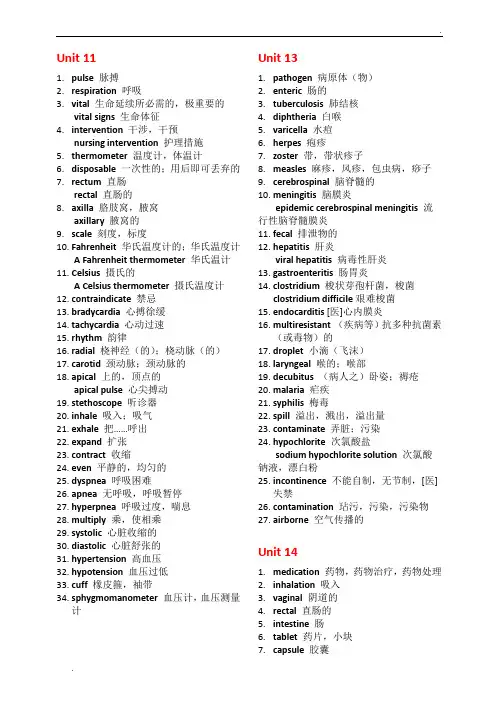
..Unit 111. pulse 脉搏2. respiration 呼吸3. vital 生命延续所必需的,极重要的vital signs 生命体征 4. intervention 干涉,干预nursing intervention 护理措施 5. thermometer 温度计,体温计6. disposable 一次性的;用后即可丢弃的7. rectum 直肠rectal 直肠的8. axilla 胳肢窝,腋窝axillary 腋窝的 9. scale 刻度,标度10. Fahrenheit 华氏温度计的;华氏温度计A Fahrenheit thermometer 华氏温计 11. Celsius 摄氏的A Celsius thermometer 摄氏温度计 12. contraindicate 禁忌 13. bradycardia 心搏徐缓 14. tachycardia 心动过速 15. rhythm 韵律16. radial 桡神经(的);桡动脉(的) 17. carotid 颈动脉;颈动脉的 18. apical 上的,顶点的apical pulse 心尖搏动 19. stethoscope 听诊器 20. inhale 吸入;吸气 21. exhale 把……呼出 22. expand 扩张 23. contract 收缩24. even 平静的,均匀的 25. dyspnea 呼吸困难26. apnea 无呼吸,呼吸暂停 27. hyperpnea 呼吸过度,喘息 28. multiply 乘,使相乘 29. systolic 心脏收缩的 30. diastolic 心脏舒张的 31. hypertension 高血压 32. hypotension 血压过低 33. cuff 橡皮箍,袖带34. sphygmomanometer 血压计,血压测量计Unit 131. pathogen 病原体(物)2. enteric 肠的3. tuberculosis 肺结核4. diphtheria 白喉5. varicella 水痘6. herpes 疱疹7. zoster 带,带状疹子8. measles 麻疹,风疹,包虫病,痧子 9. cerebrospinal 脑脊髓的 10. meningitis 脑膜炎epidemic cerebrospinal meningitis 流行性脑脊髓膜炎 11. fecal 排泄物的 12. hepatitis 肝炎viral hepatitis 病毒性肝炎 13. gastroenteritis 肠胃炎14. clostridium 梭状芽孢杆菌,梭菌 clostridium difficile 艰难梭菌 15. endocarditis [医]心内膜炎16. multiresistant (疾病等)抗多种抗菌素(或毒物)的17. droplet 小滴(飞沫) 18. laryngeal 喉的;喉部19. decubitus (病人之)卧姿;褥疮 20. malaria 疟疾 21. syphilis 梅毒22. spill 溢出,溅出,溢出量 23. contaminate 弄脏;污染 24. hypochlorite 次氯酸盐sodium hypochlorite solution 次氯酸钠液,漂白粉25. incontinence 不能自制,无节制,[医]失禁26. contamination 玷污,污染,污染物 27. airborne 空气传播的Unit 141. medication 药物,药物治疗,药物处理2. inhalation 吸入3. vaginal 阴道的4. rectal 直肠的5. intestine 肠6. tablet 药片,小块7.capsule 胶囊..8. elixir 清药酒,精药酒,甘香酒剂9. suspension 悬浮,悬浮液,悬胶(体) 10. syrup 糖浆,果汁11. parenteral 肠胃外的,不经肠的,非肠道的;注射用药物12. intradermal 皮内的,皮层内的 13. subcutaneous 皮下的,皮下用的 14. intramuscular 肌内的,肌肉的 15. oncology 肿瘤学16. diabetes 糖尿病,多尿症17. allergy 过敏,过敏性,敏感症,变态反应性18. pharmacokinetics 药物(代谢)动力学 19. antibiotic 抗生的;抗生素 20. hormonal 荷尔蒙的,激素的 21. contraceptive 避孕的;避孕药,避孕品,避孕用具22. biotransformation 生物转化 23. metabolite 代谢物24. integumentary 外皮的,皮的;由皮肤构成的25. musculoskeletal 肌肉与骨骼的 26. prescribe 处(方),开(药);指示,规定prescription 处方,药方27. adverse 不利的,有害的,相反的Unit 151. dexterity 灵巧,机敏2. irretrievable 不能挽回的,不能复原的3. mandatory 命令的,强制的,托管的4. syringe 注射器;注射5. swab 棉签,药签6. disinfectant 消毒剂7. vaccination 接种疫苗,种痘;牛痘疤 8. epinephrine 肾上腺素 9. insulin 胰岛素10. erythropoietin (促)红细胞生成素 11. thigh 大腿,股12. dorsogluteal 背外侧的13. deltoid 三角形的;三角肌的deltoid muscle 三角肌 14. quadriceps 四头肌 15. femoral 股的,股骨的femoral quadriceps 股四头肌 16. coccyx 尾骨17. iliac 髂骨的,回肠的 18. spine 脊骨 iliac spine 髂嵴 19. acromion 肩峰20. precutaneous 经由皮肤的,经皮的 21. venipuncture 静脉穿刺,静脉针灸 22. peripheral 外周的,外围的 23. dorsum 背(部) 24. elbow 肘25. cannulation 管子,套管插入术 26. dressing 敷料 27. nodule 节结28. lesion 损害,身体上的伤害 29. dart 飞奔,投掷;飞快的动作 30. barrel 桶,筒,活塞筒Unit 161. neonate 婴儿,新生儿2. plasma 血浆,乳浆3. hemoglobin 血色素,血红蛋白4. thrombocytopenia 血小板减少(症)5. platelet 血小板,小盘,小板6. hemorrhage 出血7. antigen 抗原8. leukocyte 白细胞,白血球 9. fibrinogen 纤维蛋白原 10. globulin 血球素,球蛋白 11. intravascular 血管内的 12. pasteurize 用巴氏法灭菌13. hypoproteinemia 低蛋白血(症) 14. cryoprecipitate 冷凝蛋白质15. hemophiliac 血友病的;血友病患者 16. infant 婴儿,幼儿;婴儿的,幼稚的 17. bacteria 细菌 18. hemolysis 溶血Unit 171. incise 切割,切入2. contuse 打伤,挫伤,撞伤3. abrade 磨损,摩擦,折磨4. puncture 穿刺伤;刺破5. lacerate 撕裂,割碎6. contamination 玷污,污染,污染物7.alimentary 食物的,营养的 alimentary canal 消化道..8. genital 生殖的;生殖器(多用于指男性的外生殖器)9. urinary 尿的,泌尿器的 10. gastrointestinal 胃与肠的 11. spillage 溢出,溢出量 12. purulent 脓的,含脓的 13. granulation 使成粒状,有粒的表面,粗糙14. vasculature 脉管系统15. malnourished 营养失调的,营养不良的 16. depilatory 脱毛的;脱毛药 17. hemorrhage 出血 18. ligature 绷带 19. dehiscence 裂开20. evisceration 去内脏术,脏器膨出 21. specimen 标本,样本,待试验物 22. nausea 反胃,恶心,作呕,晕船23. parenteral 肠胃外的,不经肠的,非肠道的24. serosanguineous 血清血液的25. stitch 缝,缝合;一针,针脚,缝针 26. suture 缝合,缝合处,缝合用的线;缝合Unit181. intubation 插管法2. relaxant 肌肉松弛药;放松的,弛缓的3. regurgitated 反流的4. laryngoscope 喉镜5. cuff 气囊6. syringe 注射器7. atlantooccipital 寰枕的 8. epiglottis 会厌 9. cord 声带10. turbinate 鼻甲11. oesophageal 食管的,食道的 12. epigastrium 腹上部 13. bronchus 支气管14. aortic 主动脉的,大动脉的 15. intracranial 颅内的 16. aneurysm 动脉瘤17. analgesic 止痛剂,镇痛药Unit191. suction 吸;抽吸;抽吸器;吸引术,吸痰2. secretion 分泌物3. cyanotic 发绀的,青紫的4. sterile 灭菌的;消毒的5. sputum 痰6. microorganism 微生物7. dominant 优势的;支配的8. contamination 污染;沾染9. nostril 鼻孔10. tracheostomy 气管造口术Unit201. cardiopulmonary 心肺的;与心肺有关的2. resuscitation 苏醒;复活;复苏;复苏术3. hemodynamic 血液动力学的,血液动力的4. spontaneous 任意的;自发的5. ventricular 室的,心室的,似心室的6. ventilation 通风;换气7. electrocardiogram 心电图(ECG) 8. defibrillation 心脏除颤;除颤 9. pharmacologic 药理学的 10. jaw 颌;颚 11. chin 颏12. sternum 胸骨Unit221. shock 休克2. cardiovascular 心脏血管的3. intravascular 血管内的4. anaphylaxis 过敏性反应5. disseminate 播散,弥散6. coagulation 凝结、凝结物7. episode 发作,偶发事件8. ischemic 局部缺血的9. endothelial 内皮的10. precipitate 加速,促使,促成 11. cerebral 脑的,大脑的 12. gastrointestinal 胃与肠的 13. hypovolemic 血容量减少的.hypovolemia 血容量减少,血容量过低14.spleen 脾15.trauma 外伤,损伤16.cardiogenic 心源性的,心脏性的17.extracardiac 心外的18.distributive 分配的,分布的,分布性的19.venule 小静脉20.arteriole细动脉21.clammy湿粘的,湿冷的22.bluish 带蓝色的,带青色的23.profuse很多的,大量的,极其丰富的24.perfusion 灌注,充满25.oximetry 血氧定量,血氧定量法26.deterioration恶化;变坏;退化恶化27.tachypnea 呼吸促迫,呼吸急促28.asepsis无菌,防腐处理,灭菌法29.cannula 套管.。
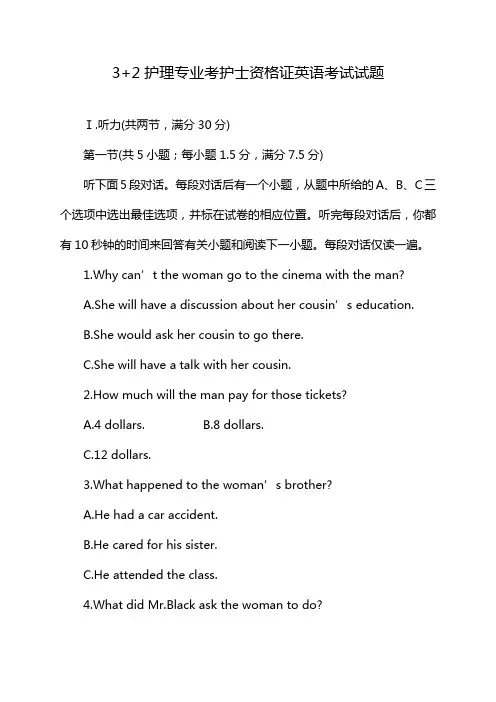
3+2护理专业考护士资格证英语考试试题Ⅰ.听力(共两节,满分30分)第一节(共5小题;每小题1.5分,满分7.5分)听下面5段对话。
每段对话后有一个小题,从题中所给的A、B、C三个选项中选出最佳选项,并标在试卷的相应位置。
听完每段对话后,你都有10秒钟的时间来回答有关小题和阅读下一小题。
每段对话仅读一遍。
1.Why can’t the woman go to the cinema with the man?A.She will have a discussion about her cousin’s education.B.She would ask her cousin to go there.C.She will have a talk with her cousin.2.How much will the man pay for those tickets?A.4 dollars.B.8 dollars.C.12 dollars.3.What happened to the woman’s brother?A.He had a car accident.B.He cared for his sister.C.He attended the class.4.What did Mr.Black ask the woman to do?A.To type something important.B.To see an interesting movie.C.To send a notice to him.5. What’s the possible relationship between the two speakers?A.Passenger and driver.B.Husband and wife.C.Guide and visitor.第二节(共15小题;每小题1.5分,满分22.5分)听下面5段对话或独白。
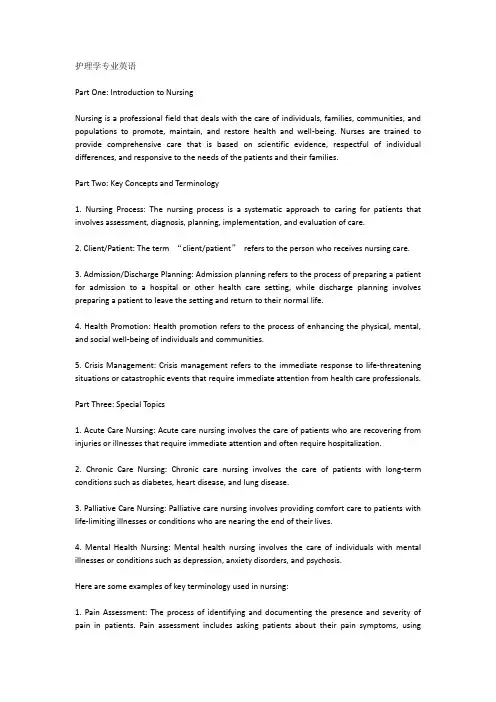
护理学专业英语Part One: Introduction to NursingNursing is a professional field that deals with the care of individuals, families, communities, and populations to promote, maintain, and restore health and well-being. Nurses are trained to provide comprehensive care that is based on scientific evidence, respectful of individual differences, and responsive to the needs of the patients and their families.Part Two: Key Concepts and Terminology1. Nursing Process: The nursing process is a systematic approach to caring for patients that involves assessment, diagnosis, planning, implementation, and evaluation of care.2. Client/Patient: The term “client/patient”refers to the person who receives nursing care.3. Admission/Discharge Planning: Admission planning refers to the process of preparing a patient for admission to a hospital or other health care setting, while discharge planning involves preparing a patient to leave the setting and return to their normal life.4. Health Promotion: Health promotion refers to the process of enhancing the physical, mental, and social well-being of individuals and communities.5. Crisis Management: Crisis management refers to the immediate response to life-threatening situations or catastrophic events that require immediate attention from health care professionals.Part Three: Special Topics1. Acute Care Nursing: Acute care nursing involves the care of patients who are recovering from injuries or illnesses that require immediate attention and often require hospitalization.2. Chronic Care Nursing: Chronic care nursing involves the care of patients with long-term conditions such as diabetes, heart disease, and lung disease.3. Palliative Care Nursing: Palliative care nursing involves providing comfort care to patients with life-limiting illnesses or conditions who are nearing the end of their lives.4. Mental Health Nursing: Mental health nursing involves the care of individuals with mental illnesses or conditions such as depression, anxiety disorders, and psychosis.Here are some examples of key terminology used in nursing:1. Pain Assessment: The process of identifying and documenting the presence and severity of pain in patients. Pain assessment includes asking patients about their pain symptoms, usingvisual analog scales, and checking for physiological changes such as increased heart rate and respiratory rate.2. Compression Therapy: The use of pressure devices such as bandages or socks to reduce swelling and bruising after trauma or surgery. Compression therapy is commonly used in orthopedic and vascular nursing.3. Oxygen Therapy: The delivery of oxygen to patients who require supplemental oxygen for respiratory conditions such as chronic obstructive pulmonary disease (COPD) or asthma. Oxygen therapy is commonly used in respiratory nursing.4. Nebulization: The process of atomizing medication into fine droplets that can be inhaled by patients to enhance absorption and delivery to the lungs for treatment of respiratory conditions. Nebulization is commonly used in pulmonary nursing.Part Four: Writing a Professional Nursing Letter and ReportIn this section, we will demonstrate how to write a professional nursing letter and report that follows a clear structure and appropriate language. We will also include sample letters and reports that demonstrate typical content and format.Summary: These were some of the key terms and concepts used in nursing along with examples of how they are used in practice. It is essential for nurses to have a strong foundation in nursing knowledge and skills to provide effective care to patients and families.。
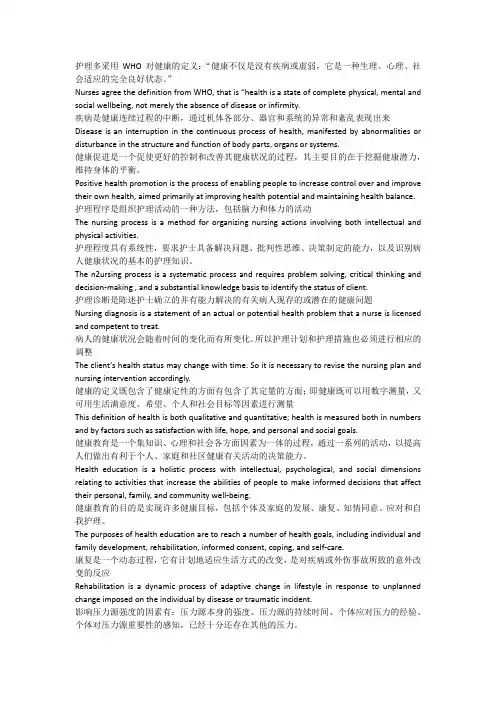
护理多采用WHO对健康的定义:“健康不仅是没有疾病或虚弱,它是一种生理、心理、社会适应的完全良好状态。
”Nurses agree the definition from WHO, that is “health is a state of complete physical, mental and social wellbeing, not merely the absence of disease or infirmity.疾病是健康连续过程的中断,通过机体各部分、器官和系统的异常和紊乱表现出来Disease is an interruption in the continuous process of health, manifested by abnormalities or disturbance in the structure and function of body parts, organs or systems.健康促进是一个促使更好的控制和改善其健康状况的过程,其主要目的在于挖掘健康潜力,维持身体的平衡。
Positive health promotion is the process of enabling people to increase control over and improve their own health, aimed primarily at improving health potential and maintaining health balance. 护理程序是组织护理活动的一种方法,包括脑力和体力的活动The nursing process is a method for organizing nursing actions involving both intellectual and physical activities.护理程度具有系统性,要求护士具备解决问题、批判性思维、决策制定的能力,以及识别病人健康状况的基本的护理知识。
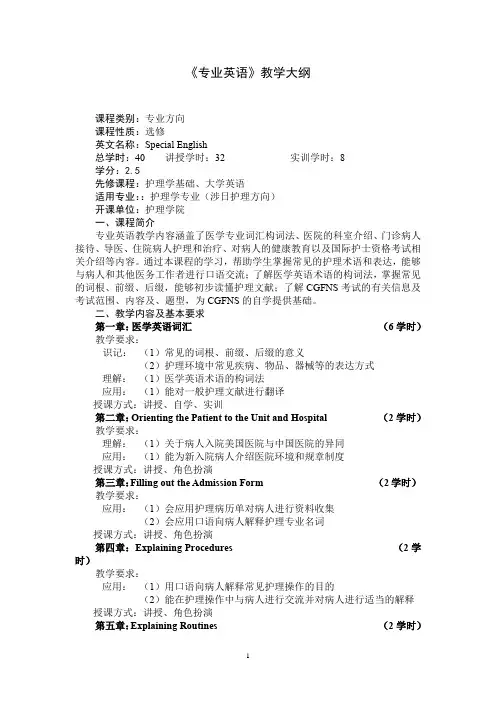
《专业英语》教学大纲课程类别:专业方向课程性质:选修英文名称:Special English总学时:40 讲授学时:32 实训学时:8学分:2.5先修课程:护理学基础、大学英语适用专业::护理学专业(涉日护理方向)开课单位:护理学院一、课程简介专业英语教学内容涵盖了医学专业词汇构词法、医院的科室介绍、门诊病人接待、导医、住院病人护理和治疗、对病人的健康教育以及国际护士资格考试相关介绍等内容。
通过本课程的学习,帮助学生掌握常见的护理术语和表达,能够与病人和其他医务工作者进行口语交流;了解医学英语术语的构词法,掌握常见的词根、前缀、后缀,能够初步读懂护理文献;了解CGFNS考试的有关信息及考试范围、内容及、题型,为CGFNS的自学提供基础。
二、教学内容及基本要求第一章:医学英语词汇(6学时)教学要求:识记:(1)常见的词根、前缀、后缀的意义(2)护理环境中常见疾病、物品、器械等的表达方式理解:(1)医学英语术语的构词法应用:(1)能对一般护理文献进行翻译授课方式:讲授、自学、实训第二章:Orienting the Patient to the Unit and Hospital (2学时)教学要求:理解:(1)关于病人入院美国医院与中国医院的异同应用:(1)能为新入院病人介绍医院环境和规章制度授课方式:讲授、角色扮演第三章:Filling out the Admission Form (2学时)教学要求:应用:(1)会应用护理病历单对病人进行资料收集(2)会应用口语向病人解释护理专业名词授课方式:讲授、角色扮演第四章:Explaining Procedures (2学时)教学要求:应用:(1)用口语向病人解释常见护理操作的目的(2)能在护理操作中与病人进行交流并对病人进行适当的解释授课方式:讲授、角色扮演第五章:Explaining Routines (2学时)识记:(1)常用护理常规的表达方式(2)美国护理环境中温度、体重、身高的表达方式应用:(1)会用口语向病人解释常见护理常规的意义授课方式:讲授、角色扮演第六章:Preoperative Care (2学时)教学要求:理解:(1)“知情同意书”的意义(2)交班制度应用:(1)会对术前病人进行饮食、备皮等方面的健康教育(2)会向病人解释术后常见并发症及其原因、预防措施授课方式:授课方式:讲授、角色扮演第七章:Postoperative Care (2学时)教学要求:应用:(1)会对术后病人进行呼吸运动、下床活动的指导授课方式:讲授、角色扮演第八章:Emergency Care (2学时)教学要求:识记:(1)收集病人过去病史和现病史的表达应用:(1)能对心脏病病人进行护理评估授课方式:讲授、角色扮演第九章:Coronary Care Unit (2学时)教学要求:应用:(1)能说出常用的急救设备(2)会向病人解释常见急救设备的用途授课方式:讲授、角色扮演第十章:Obstetrics (2学时)教学要求:识记:(1)对孕妇问诊的常用表达方式应用:(1)能对孕妇进行饮食、运动、用药等方面的健康教育授课方式:讲授、角色扮演第十一章:Discharge Planing (2学时)教学要求:识记:(1)对病人进行出院指导的内容应用:(1)能说出含钾高的食物(2)能对高血压病人进行饮食指导与用药指导授课方式:讲授、角色扮演第十二章:CGFNS简介(4学时)教学要求:理解:(1)CGFNS考试应用:(1)会做简单的CGFNS考试题目授课方式:讲授、课堂作业法第十三章:Patient Education: Medication (4学时)应用:(1)能对病人进行药物治疗方面健康教育授课方式:讲授、角色扮演第十四章:Patient Education: Examination (6 学时)教学要求:应用:(1)能对病人解释常见检查的目的,并进行指导授课方式:讲授、角色扮演三、其他教学环节安排四、考核方式(1)平时成绩:30%学习态度:10分翻译及读书笔记汇报:10分角色扮演实训报告:10分(2)期末考核:70%笔试:70分五、教材及主要参考书(1)教材:Judith Perry,蔡碧华.护理美语.XX:科学出版社,2006.(2)主要参考书:宋军.护理专业英语.XX:人民卫生出版社,2006.Smeltzer,S. C. O. and Bare,B. G.Brunner & Suddarth's Textbook of Medical-Surgical Nursing (10th Ed). Philadelphia,PA.Lippincott Williams & Wilkins,2004.。
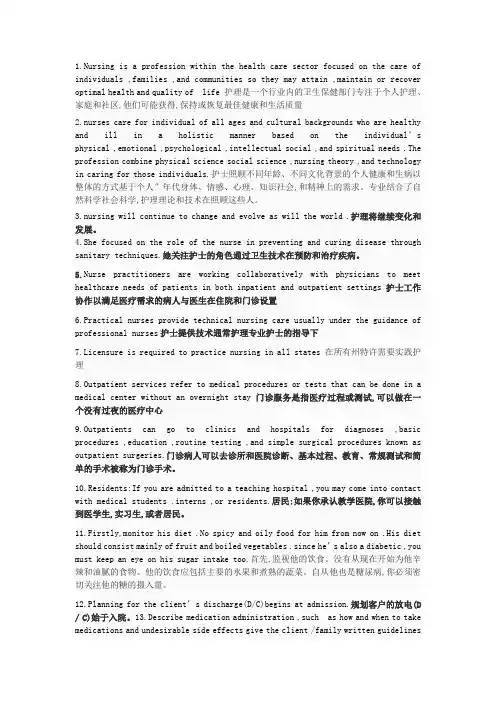
1.Nursing is a profession within the health care sector focused on the care of individuals ,families ,and communities so they may attain ,maintain or recover optimal health and quality of life 护理是一个行业内的卫生保健部门专注于个人护理、家庭和社区,他们可能获得,保持或恢复最佳健康和生活质量2.nurses care for individual of all ages and cultural backgrounds who are healthy and ill in a holistic manner based on the individual’s physical ,emotional ,psychological ,intellectual social ,and spiritual needs .The profession combine physical science social science ,nursing theory ,and technology in caring for those individuals.护士照顾不同年龄、不同文化背景的个人健康和生病以整体的方式基于个人”年代身体、情感、心理、知识社会,和精神上的需求。
专业结合了自然科学社会科学,护理理论和技术在照顾这些人。
3.nursing will continue to change and evolve as will the world .护理将继续变化和发展。
4.She focused on the role of the nurse in preventing and curing disease through sanitary techniques.她关注护士的角色通过卫生技术在预防和治疗疾病。
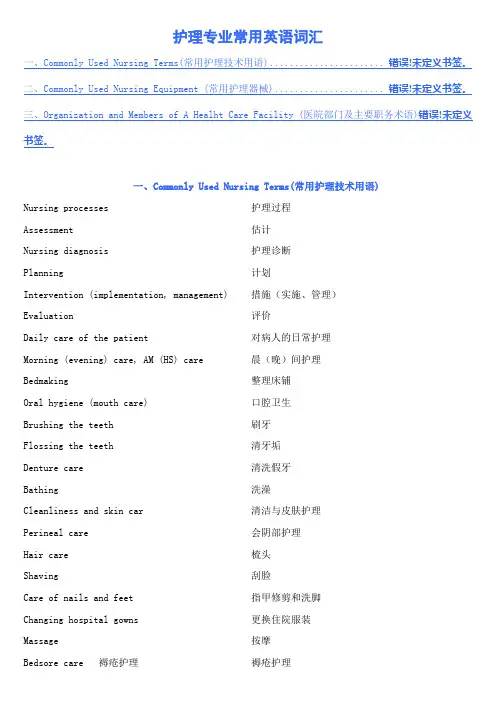
护理专业常用英语词汇一、Commonly Used Nursing Terms(常用护理技术用语) ....................... 错误!未定义书签。
二、Commonly Used Nursing Equipment (常用护理器械) ...................... 错误!未定义书签。
三、Organization and Members of A Healht Care Facility (医院部门及主要职务术语)错误!未定义书签。
一、Commonly Used Nursing Terms(常用护理技术用语)Nursing processesAssessmentNursing diagnosisPlanningIntervention (implementation, management) EvaluationDaily care of the patientMorning (evening) care, AM (HS) care BedmakingOral hygiene (mouth care)Brushing the teethFlossing the teethDenture careBathingCleanliness and skin carPerineal careHair careShavingCare of nails and feetChanging hospital gownsMassageBedsore care 褥疮护理护理过程估计护理诊断计划措施(实施、管理)评价对病人的日常护理晨(晚)间护理整理床铺口腔卫生刷牙清牙垢清洗假牙洗澡清洁与皮肤护理会阴部护理梳头刮脸指甲修剪和洗脚更换住院服装按摩褥疮护理Measurement of vital signs 测量生命体征Taking oral (rectal, axillary) temperature Taking a radial pulseCounting respirationsMeasuring (taking) blood pressure CatheterizationCardiac catheterizationLaryngeal catheterization; intubation Retro-urethral catheterizationUrethral catheterizationClean techniques (medical asepsis) AsepsisIntegral asepsisDisinfectionConcomitant (concurrent) Disinfection Steam DisinfectionTerminal DisinfectionDisinfection by ultraviolet light SterilizationChemical SterilizationIntermittent Sterilization DecompressionCardiac decompressionCerebral decompressionOrbital decompressionDecompression of pericardiumGastro-intestinal decompression Decompression of rectumDecompression of spinal cordDialysis 测量生命体征测量口腔(直肠、腋下)温度测量桡动脉脉搏计呼吸次数测量血压导管插入术心导管插入术喉插管术逆行导尿管插入术尿道导管插入术消毒灭菌(医学无菌)无菌(法)完全无菌消毒随时消毒,即时消毒蒸气消毒终末消毒紫外线消毒灭菌,消毒化学灭菌法间歇灭菌法减压(术)心脏减压术脑减压术眼眶减压术心包减压术胃肠减压术直肠减压术脊髓减压术透析Peritoneal dialysisHemodialysisDrainageAspiration (suction) drainageClosed drainageNegative pressure drainageOpen drainagePostural drainageVaginal drainageVesicocelomic drainageEnemaBarium enemaBlind enemaContrast enemaGlycerin enemaHigh (low) enemaMagnesium sulfate enemaRetention (non-retention) enema Soapsuds enemaTurpentine enemaFeedingForced (forcible) feedingIntubation (tube) feedingVassal feedingRectal feedingHeat and cold applicationsApplying hot compressesApplying hot soaksAssisting the patient to take a sitz bath Applying hot water bottles 腹膜透析血液透析引流、导液吸引导液(引流)关闭引流法负压吸引法开放引流法体位引流法阴道引流法膀胱腹腔引流灌肠钡灌肠肛管排气法对比灌肠甘油灌肠高(低)位灌肠硫酸镁灌肠保留(无保留)灌肠肥皂水灌肠松节油灌肠饲,喂养强制喂养管饲法鼻饲法直肠营养法冷、热敷热敷湿热敷帮病人坐浴用热水瓶Applying cold compressesGiving a cold (an alcohol) sponge bath InfusionGlucose infusionGlucose-saline infusionSaline infusionInjectionEndermic (intracutaneous) injection Hypertonic saline injection Hypodermic injectionIntramuscular injectionIntrapleural injectionIntraocular injectionIntrauterine injectionNasal injectionPeritoneal injectionRectal injectionSubconjunctival injectionUrethral injectionVaginal injectionIrrigationVaginal irrigationBladder irrigationContinuous irrigationMediate irrigationIsolationStrict isolationContact isolationRespiratory isolationDrainage (secretion) precautions 冷敷冷水(酒精)擦浴输入,注入葡萄糖液输注葡萄糖-盐水输注盐水输注注射皮内注射高渗盐水注射皮下注射肌肉注射胸膜腔注射眼球内注射子宫内注射鼻内注射腹膜腔注射直肠注射结膜下注射尿道注射阴道注射冲洗阴道冲洗膀胱冲洗连续冲洗法间接冲洗法隔离、分离严密隔离接触隔离呼吸道隔离引流预防措施Enteric precautionsBlood (body fluid) precautions Protective isolationLavageGastric lavageIntestinal lavagePeritoneal lavagePleural lavageMedicationEndermic medicationEpidermic medication Hypodermatic medicationIonic medicationNasal medicationOral medicationRectal medicationSublingual medication Transduodenal medication Vaginal medicationSuctioningUpper airway suctioning Nasogastric suctioningWound suctioninTransfusionArterial transfusionBlood transfusionDirect (immediate) transfusion Drip transfusionIndirect transfusionPlasma transfusion 肠道预防措施血液(体液)预防措施保护性隔离灌洗,洗出法洗胃洗肠腹膜腔灌洗胸膜腔灌洗药疗,投药,给药皮内投药法皮上投药法皮下投药法离子透药疗法鼻内投药法口服法直肠投药法舌下投药法十二指肠内投药法阴道投药法吸气,引液上呼吸道抽吸鼻胃抽吸伤口吸引输血,输液动脉输血输血直接输血滴注输血(液)间接输血输血清Venous transfusionDiet nursingAbsolute diet (fasting) Balanced dietBland dietConvalescent dietDiabetic dietEucaloric dietFat-free dietSalt-free dietFever dietFull dietHalf dietHigh caloric dietHigh-carbohydrate dietHigh-protein (protein-rich) diet Invalid dietLight dietLiquid dietHigh fat dietLow fat dietLow caloric dietLow-protein dietLow-residue dietNourishing dietObesity dietPrenatal dietRegimens dietSmooth (soft) dietEmergency care (first aid) 静脉输血,静脉输液饮食护理禁食均衡饮食清淡饮食恢复期饮食糖尿病饮食适当热量饮食无脂饮食无盐饮食热病饮食全食,普通饮食半食高热量饮食高糖饮食高蛋白饮食病弱者饮食易消化饮食流质饮食高脂饮食低脂饮食低热量饮食低蛋白饮食低渣饮食滋补饮食肥胖饮食孕期饮食规定食谱细(软)饮食急救护理Cardiopulmonary resuscitationMouth-to mouth (mouth-to-nose) resuscitation Emergency care used to control hemorrhage Emergency care given to help a patient who is vomitingEmergency care for a patient during a seizure Hospice carePostmortem care 心肺复苏术口对口(口对鼻)复苏术止血措施呕吐患者急救癫痫发作急救临终护理死亡后护理一、Commonly Used Nursing Terms(常用护理技术用语) ....................... 错误!未定义书签。
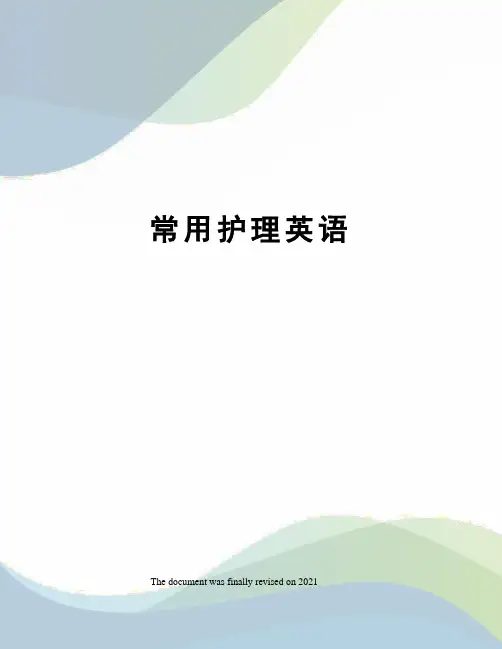
常用护理英语 The document was finally revised on 2021护理专业常用英语词汇目录一、Commonly Used Nursing Terms(常用护理技术用语)Nursing processesAssessment?Nursing diagnosisPlanningIntervention (implementation, management) EvaluationDaily care of the patientMorning (evening) care, AM (HS) care? BedmakingOral hygiene (mouth care)Brushing the teethFlossing the teethDenture careBathingCleanliness and skin carPerineal careHair careShavingCare of nails and feetChanging hospital gownsMassageBedsore care 褥疮护理Measurement of vital signs 测量生命体征Taking oral (rectal, axillary) temperature Taking a radial pulseCounting respirationsMeasuring (taking) blood pressure CatheterizationCardiac catheterizationLaryngeal catheterization; intubation 护理过程估计护理诊断计划措施(实施、管理)评价对病人的日常护理晨(晚)间护理整理床铺口腔卫生刷牙清牙垢清洗假牙洗澡清洁与皮肤护理会阴部护理梳头刮脸指甲修剪和洗脚更换住院服装按摩褥疮护理测量生命体征测量口腔(直肠、腋下)温度测量桡动脉脉搏计呼吸次数测量血压Retro-urethral catheterization Urethral catheterizationClean techniques (medical asepsis) AsepsisIntegral asepsisDisinfectionConcomitant (concurrent) Disinfection Steam DisinfectionTerminal DisinfectionDisinfection by ultraviolet light SterilizationChemical SterilizationIntermittent Sterilization Decompression?Cardiac decompressionCerebral decompressionOrbital decompression Decompression of pericardium Gastro-intestinal decompression Decompression of rectum Decompression of spinal cord DialysisPeritoneal dialysisHemodialysisDrainageAspiration (suction) drainageClosed drainageNegative pressure drainageOpen drainagePostural drainageVaginal drainageVesicocelomic drainageEnemaBarium enemaBlind enemaContrast enemaGlycerin enemaHigh (low) enemaMagnesium sulfate enema Retention (non-retention) enema 导管插入术心导管插入术喉插管术逆行导尿管插入术尿道导管插入术消毒灭菌(医学无菌)无菌(法)完全无菌消毒随时消毒,即时消毒蒸气消毒终末消毒紫外线消毒灭菌,消毒化学灭菌法间歇灭菌法减压(术)心脏减压术脑减压术眼眶减压术心包减压术胃肠减压术直肠减压术脊髓减压术透析腹膜透析血液透析引流、导液吸引导液(引流)关闭引流法负压吸引法开放引流法体位引流法阴道引流法膀胱腹腔引流Soapsuds enemaTurpentine enemaFeedingForced (forcible) feeding Intubation (tube) feedingVassal feedingRectal feedingHeat and cold applications Applying hot compressesApplying hot soaksAssisting the patient to take a sitz bath Applying hot water bottles Applying cold compressesGiving a cold (an alcohol) sponge bath InfusionGlucose infusionGlucose-saline infusionSaline infusionInjectionEndermic (intracutaneous) injection Hypertonic saline injection Hypodermic injection Intramuscular injection Intrapleural injectionIntraocular injectionIntrauterine injectionNasal injectionPeritoneal injectionRectal injectionSubconjunctival injectionUrethral injectionVaginal injectionIrrigationVaginal irrigationBladder irrigationContinuous irrigationMediate irrigationIsolationStrict isolationContact isolation 灌肠钡灌肠肛管排气法对比灌肠甘油灌肠高(低)位灌肠硫酸镁灌肠保留(无保留)灌肠肥皂水灌肠松节油灌肠饲,喂养强制喂养管饲法鼻饲法直肠营养法冷、热敷热敷湿热敷帮病人坐浴用热水瓶冷敷冷水(酒精)擦浴输入,注入葡萄糖液输注葡萄糖-盐水输注盐水输注注射皮内注射高渗盐水注射皮下注射肌肉注射胸膜腔注射眼球内注射子宫内注射鼻内注射Respiratory isolation Drainage (secretion) precautions Enteric precautionsBlood (body fluid) precautions Protective isolationLavageGastric lavageIntestinal lavagePeritoneal lavagePleural lavageMedicationEndermic medication Epidermic medication Hypodermatic medicationIonic medicationNasal medicationOral medicationRectal medicationSublingual medication Transduodenal medication Vaginal medication SuctioningUpper airway suctioning Nasogastric suctioningWound suctionin TransfusionArterial transfusionBlood transfusionDirect (immediate) transfusion Drip transfusionIndirect transfusionPlasma transfusionVenous transfusionDiet nursingAbsolute diet (fasting) Balanced dietBland dietConvalescent dietDiabetic dietEucaloric diet 腹膜腔注射直肠注射结膜下注射尿道注射阴道注射冲洗阴道冲洗膀胱冲洗连续冲洗法间接冲洗法隔离、分离严密隔离接触隔离呼吸道隔离引流预防措施肠道预防措施血液(体液)预防措施保护性隔离灌洗,洗出法洗胃洗肠腹膜腔灌洗胸膜腔灌洗药疗,投药,给药皮内投药法皮上投药法皮下投药法离子透药疗法鼻内投药法口服法直肠投药法舌下投药法十二指肠内投药法阴道投药法吸气,引液Fat-free dietSalt-free dietFever dietFull dietHalf dietHigh caloric dietHigh-carbohydrate dietHigh-protein (protein-rich) dietInvalid dietLight dietLiquid dietHigh fat dietLow fat dietLow caloric dietLow-protein dietLow-residue dietNourishing dietObesity dietPrenatal dietRegimens dietSmooth (soft) dietEmergency care (first aid) Cardiopulmonary resuscitationMouth-to mouth (mouth-to-nose) resuscitationEmergency care used to control hemorrhage?Emergency care given to help a patient who is vomitingEmergency care for a patient during a seizure?Hospice carePostmortem care 上呼吸道抽吸鼻胃抽吸伤口吸引输血,输液动脉输血输血直接输血滴注输血(液)间接输血输血清静脉输血,静脉输液饮食护理禁食均衡饮食清淡饮食恢复期饮食糖尿病饮食适当热量饮食无脂饮食无盐饮食热病饮食全食,普通饮食半食高热量饮食高糖饮食高蛋白饮食病弱者饮食易消化饮食流质饮食高脂饮食低脂饮食低热量饮食低蛋白饮食低渣饮食滋补饮食肥胖饮食孕期饮食规定食谱细(软)饮食急救护理心肺复苏术口对口(口对鼻)复苏术止血措施呕吐患者急救癫痫发作急救临终护理死亡后护理二、Commonly Used Nursing Equipment (常用护理器械)Absorbent cotton Adhesive plaster BandageBath towelCotton wool balls WipesDressingElastic bandage GauzeMaskMattressRubber sheet SwabAlcohol burner Breast pump Curet(te) DropperEnema can Enema syringe Finger stall Forceps Hemostatic forceps 脱脂棉胶布绷带浴巾棉球棉球敷料弹力绷带纱布口罩垫子橡皮单拭子,药签酒精灯吸奶器刮器,刮匙滴管灌肠筒灌肠注射器Obstetric forcepsFunnelGastric tubeGlass measure cup Hypodermic syringeNeedleAmpoule (ampute)Ice bagIncubatorKidney basinMeasuring tapeMedicine cupMurphy’s drip bulb Percussion hammerRectal tubeRubber air ringRubber glovesSand bagScalpelScissorsSpecimen container Sphygmomanometer StethoscopeSuckerRibbon gutTest tubeThermometerThree-channel tubeSpatula (padded tongue blade) Tourniquet?TrayUltraviolet lampVessel clampVialBedside commodeBedside railsBedpanDisposable collecting bag Emesis basinPatient pack 指套钳子止血钳产钳漏斗胃管玻璃量杯皮下注射器针头安瓿冰袋保温箱弯盘带尺药杯墨菲氏滴管叩诊锤肛管橡皮气圈橡皮手套沙袋手术刀剪刀取样器皿血压计听诊器吸管肠线试管体温计三腔管压舌板止血带托盘紫外线灯Urinal?BinderSlingSlintScrotal supportCane (walking stick) CrutchStretcherWalkerWheelchairIsolation unit, set-up Cannula(e)Perfusion cannula Wash-out cannula CatheterCardiac catheter Indwelling catheter Double current catheter Flexible catheter Female catheter Prostatic catheter Tracheal catheter? DialyserDialyzatorDrainage-tube EnematorIntubatorIrrigatorOxygen tankRubber-topped hemostat SpeculumAnal speculumAural speculumEye speculumNasal speculum Speculum orisRectal speculum Urethral speculum 止血钳,血管夹药瓶床边洗脸台,便桶床栏床上便盆一次性集尿袋盂盆医院为病人提供的个人用具男用尿壶,贮尿器腹带,绷带悬带夹板阴囊托手杖拐杖担架助行器轮椅消毒室,消毒病房套管、插管灌注套管冲洗套管导管心导管留置导尿管双腔导管软导管女导尿管前列腺导尿管气管吸引导管透析膜透析器引流管灌肠器插关器、喉管插入器Vaginal speculumSuctionSputum suction apparatu Mechanical suctionVentilator (respirator) Automatic ventilatorPositive pressure ventilator Negative pressure ventilator Cabinet respiratorAutoclave sterilizer (disinfector) BronchoscopeCystoscopeDefibrillator Electrocardiograph Electroencephalograph GastroscopeHyperbaric oxygen chamber PacemakerSpirometer 冲洗器氧气筒带橡皮头的止血器窥器,张口器肛门张开器,扩肛器耳窥器,耳镜开睑器鼻窥器,鼻镜张口器直肠窥器,直肠张开器尿道窥器阴道窥器吸吮器吸痰器机械吸吮器呼吸机,呼吸器自动呼吸机正压呼吸机负压呼吸机箱式呼吸器高压蒸汽灭菌器支气管镜膀胱镜除颤器心电图机脑电图机胃镜高压氧仓起搏器肺活量计三、Organization and Members of A Healht Care Facility (医院部门及主要职务术语)Hospital superintendent / director/ administrator Medical directorDepartment headAttending physician/ doctor in charge Resident doctorPhysician‘s assistantInternDirector of nursingNursing education directorNursing supervisorHead nurseRegistered nurse(RN)Licensed practical nurse(LRN)Nursing assistantOrderlyGeneral office of the hospitalOut-patient departmentOut-patientIn-patient departmentOut-patientEmergency department (unit)Nursing departmentRegistration/ registrar’s officeMedical records divisionAdmission officeDepartment of internal medicineInternist , physicianDepartment of general medicineGeneral practitionerDepartment of cardiologyCardiologist ,heat specialistDepartment of respiratory medicine Department of digestive medicine(G. I. department )Gastrologist 医院院长医务主任科主任主治医师住院医师医生助理,医士实习医生护理部主任护理教育处长总护士长护士长注册护士持照护士,护士助理护士,护理员护理员,卫生员,男助理护士院部办公室门诊部门诊病人住院部住院病人急诊部护理部挂号室病案室住院处内科内科医生大内科全科医生心内科心脏专家Department of proctology ProctologistDepartment of hepatology HepatologistDepartment of nephrology NephrologistDepartment of hemotology HemotologistDepartment of endocrinology Endocrinologist?Department of neurologyNeurologistDepartment of psychiatryPsychiatristDepartment of geriatrics Geriatrician?Department of (general) surgery SurgeonDepartment of neuro-surgery Department of thoracic/ chest surgery Department of cardiovascular surgery Department of esthetic surgery Department of abdominal surgery Department of orthopedics Orthopedist?Department of plastic surgery Department of anesthesiology AnesthetistDepartment of obstetrics and gynecology Obstetrician/ accoucheur(F.) GynecologistMidwife/accoucheuse(F.) Department of pediatricsPediatricianDepartment of neonatology NeonatologistDepartment of ophthalmology OphthalmologistOculistOptician 呼吸科消化科胃病专家(医生)肛肠科肛肠科专家(医生)肝病科肝病专家(医生)肾内科肾内科专家(医生)血液科血液科专家(医生)内分泌科内分泌专家(医生)神经科神经科专家(医生)神经病科神经病专家(医生)老年病科老年病专家(医生)普通外科外科医生神经外科胸外科心血管外科美容外科腹外科矫形外科、骨科骨科医生整形外科麻醉科麻醉师妇产科产科医生妇科专家(医生)助产士Department of stomatology StomatologistDepartment of dentistryDental departmentDentistDepartment of orthodonticsOrthodontistDepartment of otorhinolaryngology/ENT(ear,nose,throat) department Otorhinolaryngologist)OtolaryngologistENT specialistAurist/ otologistRhinologistLaryngologistDepartment of dermatology DermatologistDepartment of traditional Chinese medicine? TCM physician/ doctorDepartment of acupuncture AcupuncturistDepartment of massageMassagistDepartment of pathologyPathologistDepartment of radiologyRadiologistX-ray technologistX-ray technician?Department of physical therapy Department of radioisotopeDepartment of dieteticsDietitian/ dieticianDiet technicianCookChefPharmacyDispensaryPharmacist? 小儿科儿科医生新生儿科新生儿科专家(医生)眼科眼科专家(医生)眼科医生验光师口腔科口腔科专家(医生)牙科牙科牙医师正牙科正牙专家(医生)耳鼻喉科耳鼻喉科耳鼻喉科专家(医生)耳鼻喉科专家(医生)耳鼻喉科专家(医生)耳科医生鼻科医生喉科医生皮肤科皮肤科专家(医生)中医科中医大夫针灸科针灸师按摩科按摩师病理科病理学家放射科放射科专家Pharmaceutist(Br.) Druggist(Am.) DispenserClinical laboratory Laboratory technician AssayerPulmonary function lab Nursing station/desk Intensive Care Unit(ICU) Blood bankMortuaryWaiting room Consulting room Bronchoscop roomroomroomGastro-endoscopic room Disinfection room Dressing room Injection room Therapeutic room Operating room Recovery room Medical wardSurgical ward Maternity ward Isolation wardGeneral ward Observation ward Optical ward Children’s wardMale wardPrivate ward X光技师X光技术员体疗科放射性同位素科营养科营养师营养技术人员炊事员厨师药房药房制剂师制剂师药剂师药剂士临床化验室化验室技术员化验师肺功能检查室护理站监护室血库太平间接待室、会客室、候诊室咨询室支气管镜室心电图室脑电图室胃镜室消毒室换药室注射室治疗间手术室康复室内科病房外科病房产科病房隔离病房普通病房观察病房眼科病房儿童病房男病房特等病房。
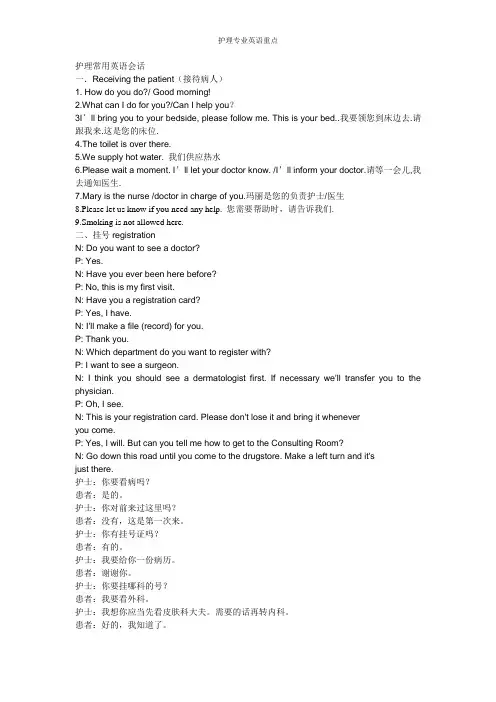
护理常用英语会话一.Receiving the patient(接待病人)1. How do you do?/ Good morning!2.What can I do for you?/Can I help you?3I’ll bring you to your bedside, please follow me. This is your bed..我要领您到床边去.请跟我来.这是您的床位.4.The toilet is over there.5.We supply hot water. 我们供应热水6.Please wait a moment. I’ll let your doctor know. /I’ll inform your doctor.请等一会儿,我去通知医生.7.Mary is the nurse /doctor in charge of you.玛丽是您的负责护士/医生8.Please let us know if you need any help. 您需要帮助时,请告诉我们.9.Smoking is not allowed here.二、挂号registrationN: Do you want to see a doctor?P: Yes.N: Have you ever been here before?P: No, this is my first visit.N: Have you a registration card?P: Yes, I have.N: I'll make a file (record) for you.P: Thank you.N: Which department do you want to register with?P: I want to see a surgeon.N: I think you should see a dermatologist first. If necessary we'll transfer you to the physician.P: Oh, I see.N: This is your registration card. Please don't lose it and bring it wheneveryou come.P: Yes, I will. But can you tell me how to get to the Consulting Room?N: Go down this road until you come to the drugstore. Make a left turn and it'sjust there.护士:你要看病吗?患者:是的。

护理英语补充词汇Unit 11 pedia-: child 儿童pediatry 小儿科pediatrician 儿科医生pediatrist 儿科医生2 gyn/e/o-, gyneco-: female 女性gynecopathy 妇科病gynecologist 妇科医生3 dent-,denti-, denta-,dento- : teeth 牙齿dentoosteitis 牙槽骨炎dentist 牙科医生dentistry 牙科dentinalgia 牙(本)质痛4 pharmaco- 药,药学pharmacal 药的,药物的pharmacochemistry 药物化学pharmacology 药理学pharmacokinetics 药物动力学pharmacopeia 药典pharmacopeial 药典的pharmacotherapy 药物疗法5 department of general surgery 普外科•department of urosurgery 泌尿外科•department of neurosurgery 神经外科•department of cardiology 心内科•department of neurology 神经内科•department of physiotherapy 理疗科•department of clinical immunology 临床免疫科•department of anesthesiology 麻醉科•department of endocrinology 内分泌科•department of dermatology 皮肤科•department of burns 烧伤科•department of nephrology 肾内科•department of orthopaedics 矫形外科•department of ophthalmology 眼科•department of periodontology 牙周病科•department of thoracic surgery 胸外科•department of haematology 血液内科•haemodialysis centre 血液透析中心•department of pharmacy 药房•department of nutriology 营养科•department of hospital infection 院内感染科department of oncology 肿瘤科admission office 住院处Unit 21 -scopy: process of visually examining 镜检,镜查法rhinoscopy照鼻镜检查, 检鼻法gastroscopy胃镜检查(法) otoscopy 耳镜检查(法) laryngoscopy喉镜检查(法) ophthalmoscopy 检眼镜检查(法) enteroscopy 肠镜检查(法) 2 -scope: instrument for viewing 窥镜rhinoscope 照鼻镜gastroscope 胃窥镜(用以检查胃内部情形), 胃窥器otoscope 耳镜laryngoscope 喉镜, 检喉镜ophthalmoscope 检眼镜enteroscope 肠镜Unit 31 ant/i: against 对抗,抑制,取消,解除antibody抗体antigen抗原antiarthritic治风湿药antibiotic抗生素antipyretic解热剂antibacterial action抗菌作用2micro- : small小,细,微microangiopathy微血管病microanalyzer微量分析仪microscope显微镜Unit 41 ur/o, urin/o, uron/o: urine 尿urination 排尿urinosocpy 验尿urology 泌尿学2 cardi/o: heart 心脏cardiogram 心电图cadiologist 心脏病专家cardiopathy 心脏病cardiography 心动描记法cardiotomy 心切开术cardiosurgery 心脏外科学cardiology 心脏病学cardiotonic 强心药,强心的cardiovascular disease 心血管病cardiotoxic 心脏中毒的cardiopulmonary 心肺的cardiopulmonary resuscitation (CPR) 心肺复苏2 over- : excess过度over-alimentation 营养过度overgrowth 生长过度overhydration 水分过多4 emergency: 1)急救2)急症1) emergency access 紧急通路emergency call 紧急呼救电话emergency call service 紧急呼救服务emergency car 急救车emergency department (ED) 急诊科emergency department nurse/ patient/ staff/ physician 急诊科护士/病人/工作人员/医生emergency medical service (EMS) 急救医疗服务emergency medical service act (EMS act) 急救医疗服务法emergency medical service system (EMSS) 急救医疗服务系统emergency medical services commission 急救医疗服务委员会emergency medical supplies 急救医疗设备emergency medical tag E. M. T. 急救医疗卡emergency medical technician急救医疗技术员emergency medical treatment 急救治疗emergency message 紧急呼救信号emergency oxygen kit 急救氧气包emergency room (ER) 急诊室emergency round 急诊(科)查房emergency run 急救出车emergency stretcher 急救担架emergency technique 急救技术emergency telecommunication 急救(应急)通讯2) emergency in cardiovascular system 心血管系统急症emergency in dermatosis 皮肤病急症emergency in digestive system 消化系统急症emergency in respiratory system 呼吸系统急症emergency in stomatosis/ stomatopathy口腔病急症Unit 51 –itis: inflammation 炎症rhinitis鼻炎, 鼻粘膜炎appendicitis阑尾炎, 盲肠炎nephritis肾炎hepatitis肝炎pneumonitis局限性肺炎, 肺炎osteitis骨炎cholecystitis胆囊炎cystitis膀胱炎arthritis关节炎urethritis尿道炎cellulitis 蜂窝织炎Unit 61 Words and phrases related to gynecology and obstetricstrichomonas vaginitis 滴虫性阴道炎vaginal moniliosis 阴道念珠菌病functional uterine bleeding 功能性子宫出血ovarian cyst 卵巢囊肿lower abdominal pain 下腹疼痛dysmenorrhea 痛经menstrual disorder 月经失调hysteromyoma 子宫肌瘤h(a)ematuria 尿血early pregnancy 早孕antenatal examination/ prenatal care 产前检查placenta pr(a)evia 前置胎盘pregnancy vomiting 妊娠呕吐toxemia of pregnancy 妊娠中毒症about to give birth 临产contraception 避孕sterility 不孕2 –ectomy: removal 切除术nephrectomy 肾切除术splenectomy 脾切除术partial gastrectomy 胃部分切除术adenectomy 腺切除术appendectomy 阑尾切除术3 intra-: within 在……内部intra-arterial 动脉内的intracardiac 心脏内的intramyocardial 心肌内的intrapulmonary 肺内的intratracheal instillation 气管内滴入法intravenous therapy 静脉注射疗法intragastric 胃内的intra-abdominal 腹内的intra-articular 关节内的intracellular 细胞内的intraoperative 手术(期)中的intrathoracic胸内的intravascular 血管内的intraventricular 心室内的intracranial 颅骨内的intracranial hypertension 颅内高血压intrabronchial 支气管内的intradermal injection 皮内注射intrapericardial 心包内的intravenous drip 静脉滴注法4 mal-: bad; badly 坏,错误malabsorption 吸收障碍malformation 畸形malnutrition 营养不良malpractice 治疗错误,治疗失当malfunction 故障Unit 71 anti-: against 对抗,抑制,取消,解除antiradiation 抗辐射药antihidrotic / antiperspirant止汗药antihypertensive 抗高血压药antilithic 抗结石药antimicrobial 抗菌剂antinauseant 止恶心药antiseptic 防腐剂antipyretic/ antithermic/ antifebrile 解热药antihemorrhagic 抗出血药antihistamine 抗组织胺药anti-infectious / anti-infective 抗感染药antimalarial 抗疟药antimyasthenic 抗肌无力药antineoplastic 抗肿瘤药antiparasitic抗寄生物药antipruritic 止痒药antispasmodic 解痉药antituberculous/ antituberculotic 抗结核药antiviral/ antivirotic 抗病毒药anti-anginal 抗心绞痛药antiantidote 抗解毒药antiarrhythmic 抗心律失常药antiasthmatic止喘药anticoncipiens (contraceptive medicine) 避孕药antidiabetic 抗糖尿病药antidiuretic 抗利尿药antiedemic 消水肿药antitoxin 抗毒素antitussive 镇咳药antianemic 抗贫血药antianxietic 抗焦虑药anticoagulant 抗凝血剂anticonvulsant/ anticonvulsive 抗惊厥药antidiarrheal 止泻药antidysenteric 止痢药antiemetic 止吐药antihypercholesterolemic抗高胆固醇药antihyperglycemic抗高血糖药antihemophilic 抗血友病药2 –otomy: incision; process of cutting into 切开术nephrotomy肾切开术splenotomy脾切开术gastroenterotomy胃肠切开术arthrotomy关节切开术3 sub-: below, insufficientsubcutaneous nodule 皮下结节subcutaneous tissue 皮下组织subcutaneous hemorrhage 皮下出血submucous 粘膜下的subendocardial 心内膜下的subendocardial myocardial infraction 心内膜下心肌梗死subhepatic肝下的subnutrition 营养不足subinfection 轻感染subinflammation 轻(度)炎症subnarcotic 轻麻醉的subparalytic 轻瘫的subtotal ectomy 次全切除术subtotal gastrectomy 胃次全切除术,大部胃切除术subtotal hysterectomy 次全子宫切除术,大部子宫切除术Unit 81 –ology: discipline; subject 学科microbiology 微生物学pharmacology 药理学cytobiology 细胞生物学toxicology 毒理学parasitology寄生虫学epidemiology 流行病学obstetrics and gynecology 妇产科学neurology 神经学anesthesiology 麻醉学stomatology 口腔学Unit 91 de-: removal of 除掉deactivation 灭活性deallergization 脱敏作用decontaminant 去污(染)剂defervescent 退热剂dehydrant 脱水剂dehydration 脱水作用delactation 断奶denarcotize 脱麻醉药desensitization脱敏作用desensitizer 脱敏剂dealcoholization 脱醇作用decerebration 去脑(法)defecation 排粪delousing 灭虱defibrillation 心脏除颤defibrillator 除颤器detoxication 解毒作用detoxification 解毒,除毒depoisoning effect 解毒作用2 pedi/o-, ped/o-: child 儿童pediatric cardiac arrest 儿童心脏骤停pediatric dose 儿科剂量pediatric emergency 儿科急症pediatric nutrition 儿科病营养pediatric patient 儿科病人pediatric surgery 儿科手术pediatrics 儿科学pediatrist / pediatrician 儿科医师/ 儿科学家Unit 101 post-: after 在……以后postdiastolic 舒张期后的postepileptic 癫痫发作后的postinfectious 感染后的postmenopausal 绝经后的post-traumatic stress 创伤后(精神)紧张post-traumatic disorder创伤后(精神)障碍postdilution 后稀释法postinfarction angina pectoris 梗死后心绞痛postmastectomy exercise 乳房切除术后运动postoperative 术后postoperative secondary glaucoma 手术后继发性青光眼postpericardiotomy syndrome 心包切开术后综合征2 hem/o, hemat/o-: blood 血,血液hemochrome 血色素hemafecia/ hematochezia 便血hematemesis 呕血hemanalysis 血分析hemarthrosis 关节积血hemastatics 血液静力学hemathorax/hematothorax 血胸hematodiarrhea 血痢hematology 血液学hematopenia 血液不足hematosepsis (septicemia) 败血病/症hematotoxicosis 血中毒hematogaster 胃脘积血,血胃hematoma 血肿hematorrhea 大出血hematostatic 止血的hematotoxin/ hemotoxin 血毒素Unit 111 rhin/o-: nose 鼻子rhinalgia 鼻痛rhinitis 鼻炎rhinolith 鼻结实rhinology 鼻科学rhinopharyngitis 鼻咽炎rhinopharyngeal 鼻咽的rhinoscopy 照鼻镜检查,检鼻法rhinism 鼻音rhinolaryngology 鼻喉科学rhinologist 鼻科医生(专家)rhinoplasty 鼻整形术rhinovirus 鼻病毒2 angi/o: blood vessel 血管angioma 血管瘤angialgia 血管痛angiocardiogram 心血管X线照片angiology 血管学angiosclerosis 血管硬化angitis 血管炎angiotomy 血管切开术angiosarcoma 血管肉瘤angiospasm 血管痉挛Unit 121 hepat/o: liverhepatic 肝的hepatocirrhosis 肝硬化hepatotomy 肝切开术hepatolith 肝石hepatitis 肝炎hepatocyte 肝(实质)细胞hepatotoxic 肝(细胞)毒的hepatoscopy 肝检查2 hyper-: above; over; to an excessive degreehyperactivity 机能亢进hyperfunction 功能亢进hyperhidrosis 多汗症hyperpnea 呼吸过度hypertension 高血压,压力过大ocular hypertension 高眼压症primary hypertension 原发性高血压secondary hypertenion 继发性高血压hypertensive 高血压者;高血压的hypertensive crisis (HC) 高血压危象hyperdiuresis 多尿hyperemesis 剧吐hypermedication 用药过度hypersomnia 睡眠过度,嗜睡(症)hypertoxic 剧毒的hypertoxicity 剧毒性Unit 131 homo-: the same 同;相同homolateral 同侧的homotonia (isotonia) 等张性;等渗性homotonic 等张的;等渗的homosexuality 同性恋(爱);同性性欲homotype 同型2 hetero-: other; different 异的;杂的heterosexuality 异性恋(爱);异性性欲heterocrisis 异常危象3 peri-: around 周围periappendicitis 阑尾周炎pericarditis 心包炎pericardial (pericardiac) 心包的pericardium (pl: pericardia) 心包perimyocarditis 心包心肌炎peribronchitis 支气管周炎peridentitis 牙周炎4 immuno-: immunity免疫immunoglobulin 免疫球蛋白immunodiagnosis 免疫诊断immunologic tests 免疫学试验immunoassay 免疫测定法immunogen 免疫原immunodeficiency 免疫缺陷Unit 151 my/o-: muscle 肌肉myo-asthenia (=myasthenia) 肌无力myocardiac (非炎性)心肌病的myocardial 心肌的myocardial infarction 心肌梗死myocardiopathy 心肌病myocarditis 心肌炎toxic myocarditis 中毒性心肌炎rheumatic myocarditis 风湿性心肌炎viral myocarditis 病毒性心肌炎myoma 肌瘤myonecrosis 肌坏死myopericarditis 心肌心包炎myositis 肌炎myospasm 肌痉挛myotonia 肌强直2 chol/e- chol/o-: gallbladder; bile 胆囊;胆汁cholagogic 利胆的cholagogue 利胆剂,利胆的cholangiography 胆管造影术cholangioma 胆管瘤cholangitis 胆管炎cholecyst 胆囊cholecystic 胆囊的cholecystitis 胆囊炎cholecystalgia 胆囊痛,胆绞痛cholecystectomy 胆囊切除术cholecystotomy 胆囊切开术cholelith 胆石cholelithiasis 胆石症/病cholelithotomy 胆石切除术3 gastr/o-: stomach 胃gastrointestinal 胃肠的gastrointestinal bleeding 胃肠出血gastrointestinal obstruction胃肠梗阻gastrorrhagia 胃出血gastroscope 胃镜gastroscopy 胃镜检查(术)gastrobrosis 胃溃破(穿孔)gastroneurosis 胃神经官能症gastroparalysis 胃麻痹gastrorrhea 胃液分泌过多gastrospasm 胃痉挛4 enter/o-: intestine 肠enterobrosis 肠穿孔enterocleaner 肠冲洗器enteroptosis/enteroptosia 肠下垂enterorrhea (diarrhea) 腹泻enterospasm 肠痉挛enterotomy 肠切开术enterocholecystotomy 肠胆囊切开术enteroparalysis 肠麻醉enterorrhagia 肠出血enteroscopy 肠镜检查enterostaxis 肠渗血enterotoxemia 肠(源)性毒血症/ 肠毒血病enterovirus 肠道病毒enterotoxin 肠毒素5 over-: too much; excessive 过度的overdose 过量overtransfusion 输血过多,输液过多overventilation 换气过度overoxygenation 过量氧合作用6 vaso-: vessel 血管vasoconstriction 血管收缩vasoconstrictor 血管收缩药vasodilation 血管舒张vasospasm 血管痉挛vasodepressor 血管减压药vasopressin 血管加压素,抗利尿激素vasopressor血管加压药vasotonia 血管紧张Unit 171 hemi-: half 半hemialgia 偏侧痛hemicerebrum 大脑半球hemianesthesia 偏身麻木,偏侧感觉缺失hemicrania 偏头痛hemispherectomy 大脑半球切除术hemiparalysis (hemiplegia) 偏瘫, 半身麻痹, 半身不遂hemiplegic idiocy 偏瘫性白痴2 onc/ o-: mass, tumor 肿瘤oncology肿瘤学oncologist肿瘤学家oncogene致癌基因oncogenesis 肿瘤生成,肿瘤形成3 extra-: outside 在……的外面extrauterine 子宫外的extrauterine pregnancy 子宫外孕extravasation 外渗,外渗物4 endo-: within内部endocardiac (=endocardial)心内的,心内膜的endocarditis心内膜炎endoangiitis血管内膜炎endonephritis肾盂炎endoparasite内部寄生物, 体内寄生虫endocrine内分泌endocrinology内分泌学endocervix子宫颈内膜endocervicitis子宫颈内膜炎endogenous内生的,内源的endoscope内镜endoscopy内窥镜检查endotracheal气管内的endotracheal anesthesia气管内麻醉endotracheal intubation气管内插管enadotracheal medication气管内给药endo-intoxication内源性中毒,自体中毒endotoxin内毒素endotoxemia内毒素血症5 dys-: difficult, poor 困难的,有病的dysfunction功能失调dysmenorrhea月经困难,痛经dysplasia发育不良dyspepsia消化不良dystrophy营养失调dysbolism代谢障碍dyshidrosis/ dyshydrosis出汗障碍dysphasia言语困难, 难语症dysadaptation 眼调节障碍/不良dysglycemia 血糖代谢障碍dyshepatia 肝功能障碍dysgenesis生殖障碍, 不育dysgraphia 书写困难dysimmunity 免疫障碍dysmaturity 发育/成熟不良dysmnesia 记忆障碍dyspnea 呼吸困难dysorexia 食欲障碍dysphagia 吞咽困难dysuria排尿困难6 leuk/o-: white blood cell; white白血球,白色的或无色的leukemia 白血病leukoma 白翳,角膜白斑leukocyte 白细胞,白血球leukoderma 白斑病, 白变病leukotherapy白细胞疗法Unit 181 a-/an-:①without 无aphakia 无晶状体abacteria 无菌的atony 无力,(尤指收缩器官的)张力缺乏abiosis 无生命adermotrophia 皮肤萎缩(即无皮肤营养之意)adiaphoresis 无汗症②an- used before a vowelanesthesia 无感觉,麻醉analgesia 无痛觉,痛觉丧失anaplasia 退行发育anacholia 胆汁减少/ 缺乏anemia 贫血(无血之意), 贫血症③off 离开aspiration 吸引,(从体腔中)吸出aberrant 偏离正途的,脱轨的;(生物)异常的,畸变的2 pseud/o-: not authentic; false 假,伪pseudangina / pseudoangina 假心绞痛pseudo-blindness 伪盲pseudojaundice 假黄疸pseudoasthma 假气喘pseudocyst 假囊肿pseudo myocardial infarction 假性心肌梗死pseudophakia 假晶状体症3 laryng/o-: larynx喉;喉部laryngitis 喉炎laryngitic 喉炎的laryngeal 喉的laryngoscope 喉镜, 检喉镜laryngoscopy 喉镜检查laryngotomy 喉剖开术laryngology 喉科学laryngologist 喉科医师laryngopharyngeal 咽喉的laryngoxerosis 喉干燥3 -oma: tumor, swelling 肿瘤papilloma 乳头瘤fibroma 纤维瘤osteoma 骨瘤sarcoma肉瘤, 恶性毒瘤hysteroma 子宫瘤benign tumor 良性肿瘤malignant tumor 恶性肿瘤4 aden/o-: gland 腺adenocarcinoma 腺癌adeniform 腺状的adenitis 腺炎adenoma 腺瘤5 ot/o-: ear 耳朵otitis 耳炎otology 耳科学otologist 耳科医生otorhinolaryngologist耳鼻喉科医师otorhinolaryngology 耳鼻喉学otophone 助听器otosclerosis 耳硬化症ototoxic 耳毒性的( 指对听觉及平衡器官有毒性的) otoneuralgia 耳神经痛7 hypo-: under; inadequate 在……之下;不足hypoacidity (胃)酸过少hypoactivity 活动减少hypocytosis 血球过少,血细胞减少(症) hypoemia / anemia 贫血hypogastrium (pl. hypogastria) 下腹中部, 腹下部hypogastric 下腹部的hypogastralgia 腹下部痛, 下腹痛hypogenesis 发育不良hypoglycemia 血糖过低, 低血糖症hypoglycemic血糖过低的, 低血糖症的hypoglycemic coma 低血糖性昏迷hypoglycemosis 低血糖病hypohepatia 肝功能减退,肝功能不全hypohydration 水分过少hypopepsia 消化不良hypovolemia 血容量减少, 血容量过低hypoxemia 血氧不足,低血氧症hypoxia 组织缺氧,氧不足hypoxiadosis 细胞低氧症hypotensor / hypotensive 降血压药hypothyroidism 甲状腺功能减退Unit 191 poly-: many 多的, 多个的, 多于一的polyunsaturated多未饱和的(指有一个以上的双键或三键有机化合物的还能溶解更多溶质的) polydeficiency 多种(维生素)缺乏polydipsia 烦渴,多饮polygene 多基因ployneuralgia多神经痛polypharmacy (治疗一种疾病时的)复方用药,混杂给药, 过多给药polyuria多尿(症) polyplegia 多肌麻痹polyphagia 多食症, 杂食性polyplasmia血浆过多polycystic 多囊的polycystoma 多囊瘤polyclinic 联合诊所, 综合医院polyopia 视物显多症2 non-: 非;不non-absorbent 非吸收性的nonacid 非酸性的, 非酸味的nondevelopment 不发育nonimmune 非免疫性的nonmetal 非金属(元素)nonsaturated 不/非饱和的nonsurgical 非手术的,非外科的nonconductor 非导体,绝缘体non-insulin-dependent-diabetes mellitus(NIDDM)非胰岛素依赖性糖尿病Unit41. assessment n . 评估2. palpate v t . 触诊adj . 有触须的3. percussion n . 叩击, 叩诊法4. auscultation n . 听诊5. diagnosis n . 诊断6. evaluation n . 估价, 评价, 赋值评价7. physiologic adj . 生理的, 生理学上的8. hierarchy n . 层次, 层级9. security n . 安全, 保险10. belongingness n . 归属, 一体, 从属性11. self-esteem n . 自尊, 自负, 自大, 自尊心12. psychological adj . 心理(上) 的13. psychologist n . 心理学者14. satisfaction n . 满意, 满足, 令人满意的事物15. individual n. 个人, 个体; adj. 个别的, 个人的16. unconscious adj . 不省人事, 无意识的Unit 71. privilege n . 特权, 特别待遇, 基本公民权利, 特免2. migrant n . 候鸟, 移居者3. anticipate vt . 预期, 期望v . 预见, 可以预料4. avert v . 转移5. remedial adj . 治疗的, 补救的6. continuum n . 连续统一体, 连续7. synthesize v . 综合, 合成8. norm n . 标准, 规范9. collaboration n . 协作, 通敌10. accessible adj . 易接近的, 可到达的, 易受影响的11. integral adj . 完整的, 整体的12. const itute vt . 建立(政府) , 组成13. acceptable adj . 可接受的, 合意的14. affordable adj . 可提供的, 可给予的, 供应得起的15. deserve v t . 应受, 值得16. respiratory adj . 呼吸的Unit 111. pulse 脉搏2. respiration 呼吸3. vital 生命延续所必需的,极重要的vital signs 生命体征4. intervention 干涉,干预nursing intervention 护理措施5. thermometer 温度计,体温计6. disposable 一次性的;用后即可丢弃的7. rectum 直肠rectal 直肠的8. axilla 胳肢窝,腋窝axillary 腋窝的9. scale 刻度,标度10. Fahrenheit 华氏温度计的;华氏温度计A Fahrenheit thermometer 华氏温度计11. Celsius 摄氏的A Celsius thermometer 摄氏温度计12. contraindicate 禁忌13. bradycardia 心搏徐缓14. tachycardia 心动过速15. rhythm 韵律16. radial 桡神经(的);桡动脉(的)17. carotid 颈动脉;颈动脉的18. apical 上的,顶点的apical pulse 心尖搏动19. stethoscope 听诊器20. inhale 吸入;吸气21. exhale 把……呼出22. expand 扩张23. contract 收缩24. even 平静的,均匀的25. dyspnea 呼吸困难26. apnea 无呼吸,呼吸暂停27. hyperpnea 呼吸过度,喘息28. multiply 乘,使相乘29. systolic 心脏收缩的30. diastolic 心脏舒张的31. hypertension 高血压32. hypotension 血压过低33. cuff 橡皮箍,袖带34. sphygmomanometer 血压计,血压测量计Unit111. pulse n . 脉搏2. respiration n . 呼吸3. vital adj . 生命延续所必需的, 极重要的vital signs 生命体征4. intervention n . 干涉, 干预nursing intervention 护理措施5. thermometer n . 温度计, 体温计6. disposable a . 一次性的; 用后即可丢弃的7. rectum n . 直肠rectal adj . 直肠的8. axilla n . 胳肢窝, 腋窝axillary adj . 腋窝的9. scale [sk ei l ] n . 刻度, 标度10. Fahrenheit adj . 华氏温度计的n . 华氏温度计a Fahrenheit thermometer 华氏温度计11. Celsius adj . 摄氏的a Celsius thermometer 摄氏温度计12. contraindicate v . 禁忌13. bradycardia n . 心搏徐缓14. tachycardia n . 心动过速15. rhythm n . 韵律16. radial n . adj . 桡神经(的) ; 桡动脉(的)17. carotid n . 颈动脉adj . 颈动脉的18. apical adj . 上的, 顶点的apical pulse 心尖搏动19. stethoscope n . 听诊器20. inhale v t . vi . 吸入; 吸气21. exhale vt . vi . 把……呼出22. expand vt . vi . 扩张23. contract vi . 收缩24. even a . 平静的, 均匀的25. dyspnea n . 呼吸困难26. apnea n . 无呼吸, 呼吸暂停27. hyperpnea n . 呼吸过度, 喘息28. multiply v . 乘, 使相乘29. systolic adj . 心脏收缩的30. diastolic adj . 心脏舒张的31. hypertension n . 高血压32. hypotension n . 血压过低33. cuff n . 橡皮箍, 袖带, 一种可充气的箍带, 通常裹在前臂上, 与血压计一起使用以测量动脉的血压34. sphygmomanometer n . 血压计, 血压测量计Unit 141. medication 药物,药物治疗,药物处理2. inhalation 吸入3. vaginal 阴道的4. rectal 直肠的5. intestine 肠6. tablet 药片,小块7. capsule 胶囊8. elixir 清药酒,精药酒,甘香酒剂9. suspension 悬浮,悬浮液,悬胶(体)10. syrup 糖浆,果汁11. parenteral 肠胃外的,不经肠的,非肠道的;注射用药物12. intradermal 皮内的,皮层内的13. subcutaneous 皮下的,皮下用的14. intramuscular 肌内的,肌肉的15. oncology 肿瘤学16. diabetes 糖尿病,多尿症17. allergy 过敏,过敏性,敏感症,变态反应性18. pharmacokinetics 药物(代谢)动力学19. antibiotic 抗生的;抗生素20. hormonal 荷尔蒙的,激素的21. contraceptive 避孕的;避孕药,避孕品,避孕用具22. biotransformation 生物转化23. metabolite 代谢物24. integumentary 外皮的,皮的;由皮肤构成的25. musculoskeletal 肌肉与骨骼的26. prescribe 处(方),开(药);指示,规定prescription 处方,药方27. adverse 不利的,有害的,相反的Unit 151. dexterity 灵巧,机敏2. irretrievable 不能挽回的,不能复原的3. mandatory 命令的,强制的,托管的4. syringe 注射器;注射5. swab 棉签,药签6. disinfectant 消毒剂7. vaccination 接种疫苗,种痘;牛痘疤8. epinephrine 肾上腺素9. insulin 胰岛素10. erythropoietin (促)红细胞生成素11. thigh 大腿,股12. dorsogluteal 背外侧的13. deltoid 三角形的;三角肌的deltoid muscle 三角肌14. quadriceps 四头肌15. femoral 股的,股骨的femoral quadriceps 股四头肌16. coccyx 尾骨17. iliac 髂骨的,回肠的18. spine 脊骨iliac spine 髂嵴19. acromion 肩峰20. precutaneous 经由皮肤的,经皮的21. venipuncture 静脉穿刺,静脉针灸22. peripheral 外周的,外围的23. dorsum背(部)24. elbow 肘25. cannulation 管子,套管插入术26. dressing 敷料27. nodule 节结28. lesion 损害,身体上的伤害29. dart 飞奔,投掷;飞快的动作30. barrel 桶,筒,活塞筒Unit 161. neonate 婴儿,新生儿2. plasma 血浆,乳浆3. hemoglobin 血色素,血红蛋白4. thrombocytopenia 血小板减少(症)5. platelet 血小板,小盘,小板6. hemorrhage 出血7. antigen 抗原8. leukocyte 白细胞,白血球9. fibrinogen 纤维蛋白原10. globulin 血球素,球蛋白11. intravascular 血管内的12. pasteurize 用巴氏法灭菌13. hypoproteinemia 低蛋白血(症)14. cryoprecipitate 冷凝蛋白质15. hemophiliac 血友病的;血友病患者16. infant 婴儿,幼儿;婴儿的,幼稚的17. bacteria 细菌18. hemolysis 溶血Unit 171. incise 切割,切入2. contuse 打伤,挫伤,撞伤3. abrade 磨损,摩擦,折磨4. puncture 穿刺伤;刺破5. lacerate 撕裂,割碎6. contamination 玷污,污染,污染物7. alimentary 食物的,营养的alimentary canal 消化道8. genital 生殖的;生殖器(多用于指男性的外生殖器)9. urinary 尿的,泌尿器的10. gastrointestinal 胃与肠的11. spillage 溢出,溢出量12. purulent 脓的,含脓的13. granulation 使成粒状,有粒的表面,粗糙14. vasculature 脉管系统15. malnourished 营养失调的,营养不良的16. depilatory 脱毛的;脱毛药17. hemorrhage 出血18. ligature 绷带19. dehiscence 裂开20. evisceration 去内脏术,脏器膨出21. specimen 标本,样本,待试验物22. nausea 反胃,恶心,作呕,晕船23. parenteral 肠胃外的,不经肠的,非肠道的24. serosanguineous 血清血液的25. stitch 缝,缝合;一针,针脚,缝针26. suture 缝合,缝合处,缝合用的线;缝合Unit181. intubation 插管法2. relaxant 肌肉松弛药;放松的,弛缓的3. regurgitated 反流的4. laryngoscope 喉镜5. cuff 气囊6. syringe 注射器7. atlantooccipital 寰枕的8. epiglottis 会厌9. cord 声带10. turbinate 鼻甲11. oesophageal 食管的,食道的12. epigastrium 腹上部13. bronchus 支气管14. aortic 主动脉的,大动脉的15. intracranial 颅内的16. aneurysm 动脉瘤17. analgesic 止痛剂,镇痛药Unit191. suction 吸;抽吸;抽吸器;吸引术,吸痰2. secretion 分泌物3. cyanotic 发绀的,青紫的4. sterile 灭菌的;消毒的5. sputum 痰6. microorganism 微生物7. dominant 优势的;支配的8. contamination 污染;沾染9. nostril 鼻孔10. tracheostomy 气管造口术Unit201. cardiopulmonary 心肺的;与心肺有关的2. resuscitation 苏醒;复活;复苏;复苏术3. hemodynamic 血液动力学的,血液动力的4. spontaneous 任意的;自发的5. ventricular 室的,心室的,似心室的6. ventilation 通风;换气7. electrocardiogram 心电图(ECG)8. defibrillation 心脏除颤;除颤9. pharmacologic 药理学的10. jaw 颌;颚11. chin 颏12. sternum 胸骨。
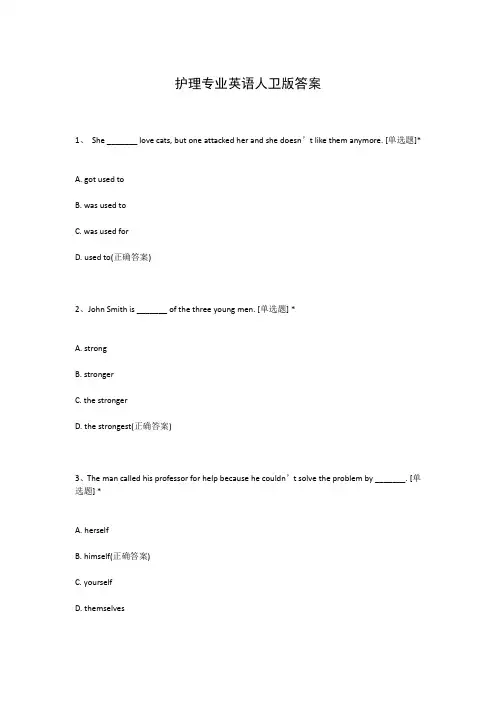
护理专业英语人卫版答案1、She _______ love cats, but one attacked her and she doesn’t like them anymore. [单选题]*A. got used toB. was used toC. was used forD. used to(正确答案)2、John Smith is _______ of the three young men. [单选题] *A. strongB. strongerC. the strongerD. the strongest(正确答案)3、The man called his professor for help because he couldn’t solve the problem by _______. [单选题] *A. herselfB. himself(正确答案)C. yourselfD. themselves4、You _____ smoke in the library, or you will be driven away. [单选题] *A. can'tB. mustn't(正确答案)C. will notD. may not5、We have ______ homework today. ()[单选题] *A. too manyB. too much(正确答案)C. much tooD. very much6、How _______ it rained yesterday! We had to cancel(取消) our football match. [单选题] *A. heavily(正确答案)B. lightC. lightlyD. heavy7、Mary _____ be in Paris. I saw her just now on campus. [单选题] *A. mustn'tB. can't(正确答案)C. need notD. may not8、You might not like the way Sam behaves, but please be kind to him. _____, he is your grandfather. [单选题] *A. After all(正确答案)B. Above allC. In allD. At all9、My father and I often go ______ on weekends so I can ______ very well. ()[单选题] *A. swim; swimmingB. swims; swimC. swimming; swimmingD. swimming; swim(正确答案)10、The managing director took the()for the accident, although it was not his fault. [单选题] *A. GuiltB. charge(正确答案)C. blameD. accusation11、I _______ the job because I couldn’t stand(忍受) the rules. [单选题] *A. gave inB. gave outC. gave backD. gave up(正确答案)12、The work will be finished _______ this month. [单选题] *A. at the endB. in the endC. by the endD. at the end of(正确答案)13、—It’s too noisy outside. I can’t fall asleep.—I can’t, either. We have to ______ new ways to solve the problem.()[单选题] *A. come up with(正确答案)B. get on withC. make up withD. catch up with14、(), it would be much more sensible to do it later instead of finishing it now. [单选题] *A. FinallyB. MildlyC. Actually(正确答案)D. Successfully15、--What are you going to be in the future?--I want to be _______ actor. [单选题] *A. aB. an(正确答案)C. theD. /16、( ) What she is worried __ is ____ her daughter is always addicted to chatting online./; that [单选题] *A /; thatB of thatC about that(正确答案)D about what17、The famous writer, _____ writings for China Daily I appreciate a lot , is invited to give a speech in our university. [单选题] *A. thatB. whose(正确答案)C. whomD. who18、The Titanic is a nice film. I _______ it twice. [单选题] *A. sawB. seeC. have seen(正确答案)D. have saw19、--Jimmy, you are supposed to?_______ your toys now.--Yes, mom. [单选题] *A. put upB. put onC. put away(正确答案)D. put down20、Let us put the matter to the vote,()? [单选题] *A. will youB. can weC. may ID. shall we(正确答案)21、Chinese people spend _____ money on travelling today as they did ten years ago. [单选题] *A. more than twiceB. as twice muchC. twice as much(正确答案)D. twice more than22、Don’t ______. He is OK. [单选题] *A. worriedB. worry(正确答案)C. worried aboutD. worry about23、( ) Some students preferred to stay in the toilet ______ do morning exercises. [单选题] *A in order to notB in not order toC in order not to(正确答案)D not in order to24、98.There is a post office ______ the fruit shop and the hospital. [单选题] *A.atB.withC.between(正确答案)D.among25、—Where are you going, Tom? —To Bill's workshop. The engine of my car needs _____. [单选题] *A. repairing(正确答案)B. repairedC. repairD. to repair26、1——May I help you? You seem to be having some problems.——_______ , thanks. Ithink I can manage. [单选题] *A. All rightB. No problemC. It’s all right(正确答案)D. There’s no way27、Mrs. Black is on her way to England. She will _______ in London on Sunday afternoon. [单选题] *A. reachB. attendC. arrive(正确答案)D. get28、During the Mid-Autumn Festival, family members often gather together _________ ameal, admire the moon and enjoy moon cakes. [单选题] *A. shareB. to share(正确答案)C. having sharedD. shared29、He does ______ in math.()[单选题] *A. goodB. betterC. well(正确答案)D. best30、Mom, I need you ______ me a pencil box.()[单选题] *A. buyB. buyingC. to buy(正确答案)D. to buying。
护理专业英语基础第一部分neur- 神经angi- 血管,管my- 肌gastr- 胃enter- 肠,小肠hepat- 肝chol- 胆cholangi- 胆管-ia表示疾病状态-algia 痛alg-仍可用作词根-dynia 痛-rrhagia 出血-ptosis下垂(可单独用)-itis 炎gastralgia 胃痛gastrodynia 胃痛gastrorrhagia 胃出血gastroptosis 胃下垂cholangiography 胆管造影术cholangiohepatitis 胆管肝炎cholangiotomy 胆管切开术(anatomy 解剖学)trache- 气管bronch - 支气管pneum- 肺,呼吸,空气pneumat- 肺,呼吸,空气肺-pathy 病path仍可作词根-logy 学说-ist 者,人员-logist 学者,学家-scopy 镜检法,检查法-graphy X线照相术,描记法,造影术card- 心/贲门dys- 不良、障碍、困难-rrhea 泛滥intra- 内erythrocyte 红细胞cyt(o) 细胞sub- 下oste- 骨centesis 穿刺术puncture 穿刺gluc(o)- /glyc(o)- 葡萄糖-penia 减少urine 尿液-gen 原albumen 蛋白albumin 清蛋白、白蛋白-lysis 溶解、消退hypo- 低hyper- 高hemat- 血液学labi- 唇dent- 齿peri- 周围pneumonopathy 肺病pneumology 肺病学neurologist 神经科医生pneumography 充气造影术,呼吸描记法vascular 血管的hypopharyngoscopecaries: decay (龋齿、骨溃疡)hepat/ic pertaining to the liversplen/o/pathy disease of the spleenhemat/o/blast an immature undifferentiated blood celllabi/o/dent/al pertaining to the lips and teethperi/cardi/um the membranous sac enclosing the heartdys/men/o/rrhea painful menstrual flow(痛经)intra/erythr/o/cyt/ic within red blood cellssub/peri/oste/al under the tissue that covers the bone (adj. 骨膜下的)contra/in/dic/a/tion that which indicates the inappropriateness of some form of treatment(禁忌症)para/centesis the surgical puncture of a body cavity in order to draw off excess fluid (穿刺术)hyperglycemia 高血糖glucopenia 低血糖glycosuria 糖尿glycogen 糖原gluc(o) - ,glyc(o) - 葡萄糖albuminuretic 蛋白尿的albuminolysis 清蛋白分解第二部分laryng(o) 喉laryngitislaryngologylaryngoparalysis (麻痹)laryngopharyngitis (咽炎)laryngoscopy 喉镜检查nas(o) -;rhin(o) - 鼻rhinorrhea (流,溢)鼻溢液rhinologist 鼻科专家nasopharyngitis (咽炎)鼻咽炎rhinocleisis (闭)鼻塞rhinodynia 鼻痛rhinolalia (音)鼻音rhinolaryngology鼻喉科学pharyng- 咽(喉)pharyngopathy 咽病pharyngodynia 咽痛pharyngolaryngitis (喉炎)咽喉炎pharyngotonsillitis 咽扁桃体炎pneum(o) -;pneumon(o) - 气,肺pneumology 肺病学pneumohemothorax 气血胸pneumonectasis (膨胀)肺气肿pneumonedeme (水肿)肺水肿pneumonemia (血液)肺充血pneumonectomy (切除术)肺切除术pneumonia 肺炎pneumonic 肺炎的pneumonopathy 肺病pneumology 肺病学pneumography 充气造影术,呼吸描记法tonsil(o) - 扁桃体tonsilloadenoidectomy 扁桃体及其腺体切除术tonsillopathy 扁桃体病tonsillectomy 扁桃体切除术tonsillitis 扁桃体炎thorac(o) - 胸thoracomyodynia 胸肌痛thoracoplasty (成形术)胸廓成形术thoracoscope 胸腔镜trache(o) - 气管tracheobronchitis (支气管炎)气管支气管炎tracheolaryngotomy 气管喉切开术tracheotomy 气管切开术-pnea 呼吸apnea 呼吸暂停dyspnea 呼吸困难bradypnea (缓慢)呼吸过慢eupnea 呼吸正常pleur(o) - 胸膜pleura 胸膜pleurodynia 胸膜痛,肋肌痛pleuritis 胸膜炎pleuropneumonia 胸膜肺炎The structure of respiration system呼吸系统结构oral cavity 口腔nasal cavity 鼻腔nasal septum 鼻中隔paranasal sinuses 鼻旁窦vocal cords 声带lower airway structures 下气道结构chest wall 胸壁the muscles of respiration 呼吸肌pulmonary artery 肺动脉pulmonary vein 肺静脉shallow respiration 浅呼吸deep breath 深呼吸tidal volume 潮气量vital capacity 肺活量expiratory cycle 呼气循环gaseous exchange 气体交换respiratory functioning 呼吸功能respiratory rate 呼吸速率respiratory center 呼吸中枢pulmonary distress 肺窘迫breath through the mouth 张口呼吸takes in oxygen and eliminates carbon dioxide吸入氧气,呼出二氧化碳sneezing reflex 打喷嚏呼吸swallowing reflex 吞咽反射upper respiratory infection上呼吸道传染restrictive lung disorder 限制性肺疾病obstructive lung disorder 阻塞性肺疾病chronic obstructive pulmonary disease慢性阻塞性肺疾患all types of pneumonia 所有类型的肺炎lobar pneumonia 大叶性肺炎interstitial pneumonia 间质性肺炎viral pneumonia 病毒性肺炎mycoplasma pneumonia 支原体肺炎bacterial pneumonia 细菌性肺炎severe acute respiratory syndrome(SARS) epistaxis, nasal bleeding 鼻出血impaired smelling 嗅觉障碍nasal discharge 鼻涕nasal obstruction 鼻塞sneeze 喷嚏snore 打鼾aphonia, loss of voice 失音症hoarseness 嘶哑gum bleeding 齿龈出血herpes labialis 唇疱疹,感冒疮Koplik’s spots 麻疹黏膜瓣(科氏斑)lead line of the gum 龈铅线salivation, drooling 流口水straw-berry tongue 草莓舌tremulous tongue 舌震颤spirometer 肺活量计fetid breath 口臭第三部分nephr(o) -; ren(o) - 肾nephrology 肾病学nephritis 肾炎nephrocolic 肾绞痛nephrolith 肾石nephroma 肾瘤nephropathy 肾病nephroptosis 肾下垂nephropyelitis 肾盂肾炎nephrotuberculosis 肾结核renopathy 肾病renovascular 肾血管的renography 肾造影术glomerul(o) - 小球;肾小球glomerulonephritis 肾小球肾炎glomerulopathy 肾小球病pyel(o) - 肾盂pyelography 肾盂造影术pyelonephritis 肾盂肾炎ureter(o) - 输尿管ureterocele 输尿管疝ureterolysis 输尿管破裂cyst(o) - 膀胱,囊,囊肿cystitis 膀胱炎cystocele 膀胱膨出cystodynia 膀胱痛cystography 膀胱造影术cystoptosis 膀胱下垂cystoscopy 膀胱镜检查urethra(o) - 尿道urethritis 尿道炎urethrocystitis 尿道膀胱炎urethrorrhagia 尿道出血urethrospasm 尿道痉挛urethrostenosis 尿道狭窄ur(o) -;urin(o) - 尿,尿道,排尿urinemia 尿毒症lith(o) - 石,结石lithocenosis 碎石清除术andr(o) - 男,雄androcyte 精子细胞androgen 雄激素acidbase 酸碱acidosis 酸中毒albumin 清蛋白albuminuria 蛋白尿alkaline 碱性analgesic 止痛剂urinary tract 尿道urethral meatus 尿道口urinary bladder 膀胱bladder tone 膀胱张力renal pelvis 肾盂renal tubule 肾小管kindy or perinephric area 肾或肾周区域vagus nerve 迷走神经epigastric region 上腹部区域cardiac sphincter 贲门括约肌pyloric sphincter 幽门括约肌biliary ducts 胆管lactosuria 乳糖尿fruity breath 呼吸有水果味ketoacidosis 酮酸中毒uremia coma 尿毒症昏迷anuria 无尿burning sensation no urination 排尿时的灼烧感dysurea 排尿困难,尿痛enuresis, bed wetting 遗尿frequency of urination 尿频micturition 排尿;频尿uresis, urination, voiding 排尿nocturia 夜尿oliguria 少尿polyuria 多尿urgency of urination 尿急urinary incontinence 尿失禁aciduria 酸尿chyluria 乳糜尿cylindruria 管型尿glycosuria 糖尿hematuria 血尿ketonuria 酮尿pneumatinuria 气尿pyuria 脓尿-----------purulent adj.脓的第四部分cardi(o) - 心脏atri(o) - 心房ventricul(o) - 心室arteri(o) - 动脉aort(o) - 主动脉coron(o) - 冠状的sten(o) - 狭窄,狭小stenosis- 狭窄brady- 慢tachy- 快,快速oligo- 少,缺少cardiovascular systerm 心血管系统cardiovascular status 心血管状态left atrium and right atrium 左右心房left ventricle and right ventricle 左右心室coronary arteries 冠状动脉heart valves 心脏瓣膜aortic valve 主动脉瓣valves of the veins 静脉瓣acrocyanosis 手足发绀acyanotic 不发绀的cardioangiology 心血管学cardiocentesis 心穿刺术cardiodynia 心痛cardiohepatomegaly 心肝肿大cardiology 心脏病学cardiomyopathy 心肌病atriomegaly 心房肥大arteriostenosis 动脉狭窄arteritis 动脉炎coronavirus 冠状病毒stenocardia 心绞痛bradycardia 心动过缓tachycardia 心动过速tachypnea 呼吸急促oligocardia 心动过缓heart murmur 心脏杂音arrhythmia 心律失常antiarrhythmic 抗心律失常药cardiocinetic 强心药cardiocirrhosis 心源性肝硬化cardiogram 心电图cardionecrosis 心脏坏死cardioneurosis 心脏神经症cardiovalvulitis 心瓣膜炎cardiology 心血管学cardiotoxic 心脏中毒的cardiac 心脏的,强心药cardioaortic 心主动脉的cardiospasm 贲门痉挛第五部分palat(o)- 腭,esophag(o) - 食管palatitis 腭炎palatoschisis 腭裂esophagitis 食管炎esophagocele 食管疝esophagogastroscopy食管胃镜检查esophagostenosis 食管狭窄esophagus 食管gastr(o)-胃,duoden-,十二指肠gastrocolitis(结肠炎)胃结肠炎gastratrophia(萎缩)萎缩性胃炎gastrectomy胃切除术gastritis 胃炎gastroduodenostomy(吻合术)胃十二指肠吻合术gastrodynia 胃痛gastrology 胃病学gastroscope 胃(窥)镜pylor(o) - 幽门pyloroduodenitis(十二指肠炎)幽门十二指肠炎pylorogastrectomy 幽门(及邻近部分胃)切除术pylorospasm 幽门痉挛pylorostenosis 幽门狭窄duoden(o) - 十二指肠gastroduodenectomy (十二指肠)胃十二指肠切除术duodenocholangeitis(胆总管炎)十二指肠胆总管炎duodenoenterostomy(肠)(吻合术)十二指肠小肠造口吻合术enter(o) - 肠,小肠enterogastritis 肠胃炎enterorrhagia 肠出血enterostenosis 肠狭窄col(o) -, 结肠;proct(o) -, 直肠coloclysis 结肠灌洗colonoscopy 结肠镜检查proctocele 直肠突出proctocolitis 直肠结肠炎splen(o)- 脾,hepat(o) - 肝splenectomy 脾切除术hepatitis 肝炎hepatomegaly 肝肿大splenohepatomegaly 肝脾肿大bil(i) -;chol(e) - 胆汁biliary 胆汁的bilirubin 胆红素cholecystalgia(囊)胆绞痛cholecystectomy 胆囊切除术cholecystitis 胆囊炎cecum 盲肠sigmoid 乙状结肠第六部分physical Assessment Examination 体格评估检查a basic screening physical examination 一般身体检查conduct the physical examination 进行体检complete or partial physical examination全面或部分体检comprehensive or problem-related history 综合或与问题相关的病史the nursing history 护理史assessment data 评估资料normal limits of vital signs 生命体征的正常值(范围)abnormal limits of vital signs 生命体征的异常值(范围)take vital signs 测生命体征approach to the patient 接近病人peripheral circulation 周围循环variations from the normal (生命体征)偏离正常值范围blood pressure 血压body temperature 体温oral temperature 口腔温度rectal temperature 直肠温度the axillary (armpit) temperature 腋下温度oral adult temperature 成人口腔温度pulse rate 脉率rhythm and depth of breathing 呼吸的节律和深度rapid (slow) respiration 快(慢)呼吸breath sounds 呼吸音inspection and palpation 视诊与触诊direct observation 直接观察indirect observation 间接观察direct percussion 直接叩诊indirect percussion 间接叩诊direct auscultation 直接听诊indirect auscultation 间接听诊clear sound 清音heart murmurs 心脏杂音duration and intensify 持续与强度nursing record 护理记录objective information 客观资料subjective information 主观资料systolic pressure 收缩压diastolic pressure 舒张压blood pressure readings 血压读数a false reading 假的读数(血压)essential blood pressure 基础血压arterial blood pressure 动脉血压peripheral resistance 周围阻力high (low) blood pressure 高(低)血压essential (primary) hypertension 原发性高血压secondary hypertension 继发性高血压take blood pressure 测血压measure body temperatu 测体温take pulse 测脉搏feel pulse 摸脉count for at least 30 seconds 至少测30sa full minute 一分钟整regular in rhythm 规律的节律strength of the pulse wave 脉搏的强度tongue depressor 压舌板cotton applicator stick 棉签absolute diet (fasting) 禁食balanced diet 均衡伙食convalescent diet 恢复期饮食diabetic diet 糖尿病饮食eucaloric diet 适当热量饮食fat-free diet 无脂饮食salt-free diet 无盐饮食fever diet 热病饮食full diet 全食,普通饮食half diet 半食high caloric diet 高热量饮食high-carbohydrate diet 高糖类饮食high-protein (protein rich) diet 高蛋白饮食low fat diet 低脂饮食low caloric diet 低热量饮食low-protein diet 低蛋白饮食low-residue diet 低渣饮食nourishing diet 滋补饮食obesity diet 肥胖病饮食prenatal diet 孕期饮食regimen diet 规定食谱smooth (soft) diet 细软饮食invalid diet 病弱者饮食light diet 易消化饮食liquid diet 流质饮食high fat diet 高脂饮食The cardiovascular system 心血管系统The circulatory system 循环系统The respiratory system 呼吸系统The digestive system 消化系统The (central) nervous system (中枢)神经系统The immune system 免疫系统The urinary system 泌尿系统The excretory system 排泄系统The reproductive / genital system 生殖系统The endocrine system 内分泌系统The muscular system / musculature 肌肉系统第七部分blood and lymph system 血液及淋巴系统red blood count (RBC) 红细胞记数complete blood count 全血细胞记数white blood cells 白细胞T4 lymphocytes T4 淋巴细胞blood products 血液制品polymorphonuclear leukocyte 多形核白细胞red cell morphology 红细胞形态学分析coagulation disorder 凝血机制紊乱erythrocyte sedimentation rate (ESR) 红细胞沉降率blood culture 血液培养bone marrow aspiration 骨髓穿刺吸引术basic metabolic rate 基础代谢率blood transfusion 输血blood component therapy 成分输血治疗homologous blood 同种异体血autologous blood 自体固有血lymph vessels 淋巴管lymph ducts 淋巴管thoracic duct 胸(淋巴导管)lymph capillaries 毛细淋巴管right lymphatic duct 右侧淋巴管lymph nodes 淋巴结acute lymphocytic leukemia 急性淋巴性白血病the growth and infiltration of leukemic cell 白血病细胞的增殖与浸润bleeding disorder 出血性疾病generally unwell 全身不适感swollen lymph glands 淋巴结肿大lymph node dissection 淋巴结解剖Endocrine system 内分泌系统thyroid gland 甲状腺parathyroid glands 甲状旁腺parathyroid hormone (PTH) 甲状旁腺激素thyroid-stimulating hormone (TSH) 促甲状腺激素thymus gland 胸腺pituitary gland 垂体腺pineal gland 松果体腺adrenal glands 肾上腺growth hormone 生长激素diabetes mellitus 糖尿病Type ⅠDiabetes mellitus 1型糖尿病Type ⅡDiabetes mellitus 2型糖尿病blood sugar 血糖blood glucose 血糖fasting blood sugar (FBS) 空腹血糖postprandial blood sugar (PPBS) 餐后血糖glucose tolerant test (GTT) 糖耐量试验diabetic ketoacidosis 糖尿病酮症酸中毒thyroid function study 甲状腺功能研究radioiodine therapy 放射性碘治疗glycosuria 糖尿hematology 血液学hematoma 血肿hematuria 血尿hemodialysis 血液透析hyperglycemia 高糖血症hyperkalemia 高钾血症hypersecretion 分泌过多hypoglycemia 低糖血症hypokalemia 低钾血症hyposecretion 分泌过少morphology 形态学thyroiditis 甲状腺炎hematonosis 血液病hematocytosis 血细胞增多hematocytopenia 血细胞减少erythr(o) - 红erythrocyte 红细胞leuk(o) - 白leukemia 白血病leukocyte 白细胞leukocytosis 白细胞增多cyt(o) - 细胞cytology 细胞学macro - 大,巨,长macrophagocyte 巨噬细胞micro- 小,微,细microbe 微生物microcirculation 微循环phag(o) - 吞噬phagocyte 吞噬细胞dialysis 透析peritoneal dialysis 腹膜透析hemodialysis 血液透析transfusion 输血arterial transfusion 动脉输血blood transfusion 输血direct (immediate ) transfusion 直接输血drip transfusion 滴注输(血)液indirect transfusion 间接输血plasma transfusion 输血浆serum transfusion 输血清venous transfusion 静脉输血,静脉输液emergency care used to control hemorrhage 止血急救terminal diseases 绝症cachexia 恶病质congestion 充血dehydration 脱水petechia 瘀点,瘀斑purpura 紫癫hypovolemia (循环)血容量减少volume 体积第八部分cerebral cortex 大脑皮质cranial nerves 脑神经(十二对)sensory nerves 感觉神经spinal nerves 脊神经motor nerves 运动神经peripheral nervous system 周围神经系统autonomic nervous system 自主神经系统sympathetic nervous system 交感神经系统parasympathetic nervous system 副交感神经系统spinal cord 脊髓cerebrospinal fluid 脑脊液cerebrovascular disease 脑血管疾病organic mental disorder 器质性精神障碍acute brain syndrome 急性脑综合症multiple sclerosis 多发性硬化cerebrovascular accident 脑血管意外cephalodynia 头痛cephalohematoma 头颅血肿cephalometry 头测量法cephalonia 巨头症cephalotomy 头部切开术;穿颅术cerebrology 脑学cerebroma 脑瘤cerebromalacia 脑软化cerebrosclerosis 脑硬化cerebrostomy 脑切开(造口)术cerebrotomy 脑切开术cerebrum 大脑encephalo-arterio/graphy 脑动脉造影术encephalodialysis 脑软化encephaloma 脑瘤encephalology 脑学encephalomyelitis 脑脊髓炎hydrocephalic 脑积水的cerebellospinal 小脑脊髓spinal- 脊的cerebellum 小脑craniology 颅骨学craniometer 测颅器craniopathy 颅病cranioplasty 颅成形术plasty 成形术craniopuncture 颅穿刺术puncture 穿刺craniotomy 颅骨切开术,穿颅术aphasia 失语ataxia- 共济失调coma 昏迷consciousness 知觉,意识unconsciousness 失去知觉convulsion 抽搐,惊厥delirium 谵妄delusion 妄想faint 昏厥hallucination 幻觉hemiplegia 偏瘫increased intracranial pressure 颅内压增高insanity 精神错乱loss of orientation 定向丧失mania 躁狂memory defects, amnesia 记忆缺损,遗忘症projectile vomiting 喷射性呕吐somnolence, (lethargy) 昏睡,嗜睡stupor 木僵,昏呆tetraplegia 四肢瘫痪paraplegia 截瘫,下身麻痹yawning 打哈欠第九部分hyperacidity 胃酸过多hyperlipidemia 高脂血症hyperdiuresis 多尿hyperemesis 剧吐hyperemia 充血hypergenesis 发育过度hypergiganto/soma 巨人症hyperglycemia 高血糖(症)hyperhidrosis n. 多汗(症)hyperleukocyt/osis 白细胞过多hypertrophy 肥大hypocalcemia 低钙血症hypocapnia 低碳酸血症hypocellular 细胞过少的Hypochromemia 血色指数过低hypoacidity 胃酸过少hypoacusis 听力减退hypoaldosteronemia 醛固酮减少症hypocrine 内分泌功能减退hypocyto/sis 血细胞减少heat and cold applications 冷、热敷applying hot compresses 热敷applying hot soaks 湿热敷assisting the patient to take a sitz bath 帮病人坐浴applying hot water bottles 用热水瓶applying an ice bag 用冰袋applying cold compresses 冷敷giving a cold (an alcohol) sponge bath 冷水(酒精)擦浴infusion 输入,注入glucose infusion 葡萄糖液输注glucose-saline infusion 葡萄糖-盐水输注saline infusion 盐水输注injection 注射endermic (intracutaneous) injection 皮内注射hypertonic saline injection 高渗盐水注射hypodermic injection 皮下注射intramuscular injection 肌内注射intraocular injection 眼球注射intrapleural injection 胸膜腔注射intrauterine injection 子宫内注射nasal injection 鼻内注射peritoneal injection 腹膜腔注射rectal injection 直肠注射subconjunctival injection 结膜下注射urethral injection 尿道注射vaginal injection 阴道注射irrigation 冲洗vaginal irrigation 阴道冲洗bladder irrigation 膀胱冲洗continuous irrigation 连续冲洗法mediate irrigation 间接冲洗法chief complaint 主诉clinical manifestation 临床表现delivery history 分娩史etiology 病因学family history 家族史history, medical history 病史precipitating(induced) 诱因marital status 婚姻状况menstrual history 月经史menarche 初潮menopause 闭经past history 既往史pathogenesis 发病机制personal history 个人史symptoms 症状cardinal symptom 主要症状classical symptom 典型症状concomitant symptom 伴发症状constitutional(systemic) symptom 全身症状indirect symptom 间接症状induced symptom 诱发症状local symptom 局部症状mental symptom 精神症状symptom-complex (syndrome)symptom 综合症,症候群signs 体征antecedent 前驱征body length (height of the body) 身高body weight 体重malaise 不适dizziness 眩晕night sweat 盗汗。
护理学专业英语unit5人卫版答案1、The teachers don't make us wear a school uniform and we can wear _____ we like. [单选题] *A. anyB. thatC. asD. what(正确答案)2、More than one student_____absent from the class yesterday due to the flu. [单选题] *A.areB.hasC.isD.was(正确答案)3、I took?some _______of the Great Wall?in China last year. [单选题] *A. potatoesB. tomatoesC. photos(正确答案)D. paintings4、There are trees on both sides of the broad street. [单选题] *A. 干净的B. 狭窄的C. 宽阔的(正确答案)D. 宁静的5、51.People usually ________ the prices before they buy something. [单选题] * A.receiveB.payC.spendD.compare(正确答案)6、I like the food very much.It is _______. [单选题] *A. terribleB. expensiveC. delicious(正确答案)D. friendly7、27.My father is a professor and he works in__________ university. [单选题] * A.a (正确答案)C./D.the8、75.Why not________ for a walk? [单选题] *A.go out(正确答案)B.to go outC.going outD.goes out9、I’ve _______ a job interview today. [单选题] *A. haveB. had(正确答案)C. hasD. have gone to10、—What’s wrong with you, Mike?—I’m really tired because I studied for today’s test ______ midnight last night. ()[单选题] *A. althoughB. unlessC. until(正确答案)11、The black coal there shows a sharp()white snow. [单选题] *A. contract withB. content withC. contact toD. contrast to(正确答案)12、Obviously they didn’t see the significance of the plan. That is()the problem lies. [单选题] *A. where(正确答案)B. whyC. /D. how13、I _______ seeing you soon. [单选题] *A. look afterB. look forC. look atD. look forward to(正确答案)14、68.—How ________ apples do you want?—I want two kilos. How ________ are they?—They are 5 yuan. [单选题] *A.much; manyB.many; much(正确答案)C.many; manyD.much; much15、It’s raining outside. Take an _______ with you. [单选题] *A. cashB. life ringC. cameraD. umbrella(正确答案)16、They lost their way in the forest, and _____ made matters worse was night began to fall. [单选题] *A. thatB. itC. what(正确答案)D. which17、Where have you _______ these days? [单选题] *A. been(正确答案)B. beC. isD. are18、Is there going to ______ a football match in the stadium next month?()[单选题] *A. beingB. haveC. be(正确答案)D. having19、38.These workers ___________ this bridge since one year ago. [单选题] * A.buildB.are buildingC.have built (正确答案)D.built20、Tom’s sister is a nurse. I met _______ in the street yesterday . [单选题] *A. sheB. hersC. himD. her(正确答案)21、75.As a student in Senior Three, I must work hard.(), I should take exercise to strengthen my body.[单选题] *A.OtherwiseB.Meanwhile(正确答案)C.ThereforeD.Thus22、40.—________ apples do we need to make fruit salad?—Let me think…We need three apples. [单选题] *A.How longB.How oftenC.How muchD.How many(正确答案)23、35.___________ good music the teacher is playing! [单选题] *A.What(正确答案)B.HowC.What aD.What the24、The strawberries ______ fresh. Can I taste (品尝) one?()[单选题] *A. watchB. tasteC. soundD. look(正确答案)25、There _____ wrong with my radio. [单选题] *A. are somethingB. are anythingC. is anythingD. is something(正确答案)26、______ visitors came to take photos of Hongyandong during the holiday. [单选题] *A. ThousandB. Thousand ofC. ThousandsD. Thousands of(正确答案)27、Can I _______ your order now? [单选题] *A. makeB. likeC. giveD. take(正确答案)28、I think ______ time with my friends is fun for me.()[单选题] *A. spendB. spendC. spending(正确答案)D. spent29、—Where did you get the book?—From my friend. I ______ it three days ago. ()[单选题] *A. lentB. borrowed(正确答案)C. keptD. returned30、Will you be able to finish your homework _______? [单选题] *A. by the timeB. in time(正确答案)C. once upon a timeD. out of time。
本科英语试题及答案护理本科英语试题及答案(护理专业)一、阅读理解(共20分,每题4分)阅读下面的文章,回答下列问题。
Text A:Nurses play a critical role in the healthcare system, providing essential care and support to patients. They are often the first point of contact for patients and their families, and their work extends beyond the hospital walls into the community. The nursing profession requires a unique combination of skills, including clinical knowledge, compassion, and the ability to communicate effectively with patients and their families.1. What is the primary role of nurses in the healthcare system?A) Conducting medical researchB) Providing essential care and support to patientsC) Administering medications onlyD) Supervising other healthcare workers2. Nurses are often the first point of contact for:A) DoctorsB) Patients and their familiesC) Hospital administratorsD) Medical students3. Which of the following is NOT a skill required for the nursing profession?A) Clinical knowledgeB) CompassionC) The ability to communicate effectivelyD) Legal expertise4. Where does the work of nurses extend to?A) Only within the hospitalB) Beyond the hospital walls into the communityC) Only in emergency roomsD) Limited to operating theaters二、词汇与结构(共20分,每题2分)用所给单词的正确形式填空。
护理专业英语高燕王晶晶版的答案1、It is my _______ to meet you here. [单选题] *A. pleasure(正确答案)B. pleaseC. pleasedD. pleasant2、Bob is young, _______ he knows a lot. [单选题] *A. becauseB. soC. but(正确答案)D. unless3、She’s _______ with her present _______ job. [单选题] *A. boring; boringB. bored; boredC. boring; boredD. bored; boring(正确答案)4、_______, making some DIY things is fashionable. [单选题] *A. Stand outB. In ones opinionC. In my opinion(正确答案)D. Out of fashion5、______! It’s not the end of the world. Let’s try it again.()[单选题] *A. Put upB. Set upC. Cheer up(正确答案)D. Pick up6、—These shoes look cool. ______ are they?—They are on sale, only $()[单选题] *A. How much(正确答案)B. How longC. How manyD. How soon7、We need two ______ and two bags of ______ for the banana milk shake.()[单选题]*A. banana; yogurtB. banana; yogurtsC. bananas; yogurt(正确答案)D. bananas; yogurts8、We were caught in a traffic jam. By the time we arrived at the airport the plane _____. [单选题] *A. will take offB. would take offC. has taken offD. had taken off(正确答案)9、When we take a trip,we usually have to _______ a hotel. [单选题] *A. takeB. stayC. book(正确答案)D. bring10、In 2019 we moved to Boston,()my grandparents are living. [单选题] *A. whoB. whenC. where(正确答案)D. for which11、—What can I do to help at the old people’s home?—You ______ read stories to the old people. ()[单选题] *A. could(正确答案)B. mustC. shouldD. would12、--What’s your _______, Jim Green?--Jim. [单选题] *A. full nameB. first name(正确答案)C. last nameD. family name13、______ in the library. ()[单选题] *A. Don’t smokingB. No smokeC. No smoking(正确答案)D. Doesn’t smoke14、If you want to be successful one day, you have to seize every _______ to realize your dream. [单选题] *A. changeB. chance(正确答案)C. chairD. check15、Which is _______ city, Shanghai, Beijing or Chengdu? [单选题] *A. largeB. largerC. largestD. the largest(正确答案)16、Look! There are some boats ______ the river.()[单选题] *A. on(正确答案)B. overC. betweenD. in17、I think you should buy this novel. It is really worth _____. [单选题] *A. reading(正确答案)B. being readC. readD. to read18、The car is _______. It needs washing. [单选题] *A. cleanB. dirty(正确答案)C. oldD. new19、I saw the boy _______?the classroom. [单选题] *A. enter intoB. enter(正确答案)C. to enter intoD. to enter20、In the closet()a pair of trousers his parents bought for his birthday. [单选题] *A. lyingB. lies(正确答案)c. lieD. is lain21、( ) ----Would you like___ tea? ----No, thanks. I have drunk two____. [单选题] *A. any, bottles of orangeB. some, bottles of orange(正确答案)C. many, bottles of orangesD. few, bottle of oranges22、17.Joe is a good student and he is busy ______ his studies every day. [单选题] * A.inB.with(正确答案)C.byD.for23、If you know the answer, _______ your hand, please. [单选题] *A. put up(正确答案)B. put downC. put onD. put in24、The bookstore is far away. You’d better _______ the subway. [单选题] *A. sitB. take(正确答案)C. missD. get25、You should stick to your()and tell him you won' t do the thing. [单选题] *A. principle(正确答案)B. qualityC. contactD. influence26、I _______ to the tape yesterday evening. [单选题] *A. lookB. listenC. listened(正确答案)D. hear27、———Must I return the book you lent me to you now? ——No, you( ). You can keep it for another few days. [单选题] *A.can’tC. mustn'tD. don, t have to(正确答案)28、She is _______, but she looks young. [单选题] *A. in her fifties(正确答案)B. at her fiftyC. in her fiftyD. at her fifties29、Li Jing often helps me ______ my geography.()[单选题] *A. atB. inC. ofD. with(正确答案)30、( ) What she is worried __ is ____ her daughter is always addicted to chatting online./; that [单选题] *A /; thatB of thatC about that(正确答案)。
Unit1 Warm-up Tasks Task 1: True or False Statements 1. T 2. T 3. F 4. F 5. T 6. F 7. F Task 2: Sentence Completion 1. primary care specialists 2. choosing to become specialists 3. alleviate those problems 4. remain a team effort 5. fewer and fewer new doctors Study & Practice I. Reading Comprehension Questions 1. B 2. D 3. B 4. D 5. A II. Words to Practice 1. unique 6. sterile 2. unitary 7. established 3. adaptive 8. vary 4. expands 9. distinct from 5. prescribe 10. supervise III. Translation A. Translate the following sentences into Chinese. 1.高级临床专科护士是接受了高等教育和培训的注册护士,大部分都有护理硕士 或博士学位;她们在不同的场所工作,包括医院、疗养院、企业、私人诊所、 学校以及社区中心;有些高级临床专科护士自己开业,但大部分都是与医生合 作开业;许多高级临床专科 护士有开具处方的权利; 2.护理的初衷是保持人们健康以及为病人提供舒适、照顾和保障;虽然护理的总 体目标历经几个世纪基本未变,但科学的进步和社会需求的变化对护理实践产 生了巨大的影响;护理逐渐发展成一门现代职业; B. Translate the following sentences into English. 1. The doctor prescribed some antibiotics for a patient with pneumonia. 2. In China, graduates from whatever nursing programs cannot enter into clinical practice until they get licensures. 3. The demand for nurses has been increasing in European and American countries in recent years. 4. In the past, the major role and functions of nurses were to provide care and comfort for the clients. 5. With the development of science and technology as well as the improvement of people’s living standards, nursing practice scopes will be expanding gradually. IV. Audio Tasks Task 1: Short -answer Questions 1. Cough and children’s ear infections. 2. Rash and anaphylactic shock. 3. Infants under the age of one. 4. Stop prescribing them unnecessarily. 5. They should not argue. Task 2: Spot Dictation 1. maladies 2. harm 3. 142000 4. allergic 5. incidence 6. majority 7. reducing 8. argue
Unit 1 Development of Nursing 护理学的发展 一、单选题: Choose the best answer from A,B,C and D according to the text. 1. Which one of the following statements is right? (A) A. Nursing before 19th century was developed slowly B. Nursing before 19th century was developed rapidly C. Nursing before 19th century was developed smoothly D. Nursing before 19th century was developed with ease 2. Which one of the following statements is right? (B) A. Florence Nightingale was born in 1825 B. Florence Nightingale was born in a wealthy family C. Florence Nightingale was born in Germany D. Florence Nightingale was not well-educated 3. How did Nurses’ Day come into being? (A) A. It came from the Birthday of Florence Nightingale B. It came from the Death date of Florence Nightingale C. It came from the date of outbreak of Crimean War D. It could not be verified 4. What is the theme of nursing? (C) A. Diagnosis B. Treatment C. Caring D. Physical examination 二、多选题: Choose the correct answers from A,B,C,D,E and F according to the text. 1. What major contributions have Florence Nightingale made for nursing? ( A B C ) A. Establishing the professional nursing B. Writing numerous nursing documents C. Establishing the First school of nursing in the world D. Publishing the First nursing Journal in the world E. Establishing the First Doctorial nursing program in the world 2. Choose the following correct concepts that dominate and shape the professional nursing practice in modern nursing? (A B E F) A. Person B. Environment C. Education D. Practice E. Health F. Nursing 3. What are the main goals of professional nursing? (A C E F) A. Health promotion B. Health education C. Health maintenance D. Disease diagnosis E. Health restoration F. Care of the dying 三、牢记下面的单词或表达法: health maintenance 保持健康 health restoration 恢复健康 care of the dying 临终关怀 四、简答题: 1. Why is nursing called the oldest art and the youngest profession? 2. What are the four main concepts of professional nursing practice?
Unit 2 Health and Illness 健康与疾病 一、单选题: Choose the best answer from A,B,C and D according to the text. 1. Which definition of health is the most widely accepted? ( D ) . A. traditional definition of health B. Nightingale’s definition of health C. the definition of ANA D. the definition of WHO 2. Which factor is not a social factor that influence health? (B ). A. family relationship B. lifestyle C. cultural background D. health care system 二、多选题: Choose the correct answers from A,B,C,D,E and F according to the text. 1. According to WHO, Health involve__( A, C, E )_ well-being. A. physical B. functional C. mental D. individual E. social 2. People’s health is influenced by __________. ( A, B, C, D, E ) A. physical factors B. emotional factors C. environmental factors D. lifestyle E. social factors 三、牢记下面的单词或表达法: illness 生病 disease疾病 greenhouse effect 温室效应 You look pale. What happened? 你脸色苍白,发生什么事了? Did you have something in your mind? You look so concerned! 你在想什么?看起来你好像有心事. 四、简答题: 1. What’s the difference between the illness and disease? 2. What are the factors that influence the health? Unit 3 Health Promotion 健康促进
一、单选题: Choose the best answer from A,B,C and D according to the text. 1. Which of the following is not included in the nursing strategies of health promotion? _________ ( D ) A. supporting behavior changes B. teaching C. coordinating D. giving injections 2. During the planning process a nurse acts as _____. (B) A. an adviser B. a resource person C. a counselor D. a consumer 二、多选题: Choose the correct answers from A,B,C,D, and E according to the text. 1. Positive health promotion is aimed primarily at ____________. ( A, C) A. improving health potential; B. treating diseases; C. maintaining health balance; D. giving injections. 三、牢记下面的单词或表达法: health promotion 健康促进 self-care 自我护理 potential problems 潜在的健康问题 四、简答题: 1. What are the purposes of health promotion? 2. briefly state the role of nurses in health promotion. Unit 4 Nursing Process 护理程序 一、单选题: Choose the best answer from A,B,C and D according to the text. 1. Which level of the Maslow’s hierarchy does self-esteem” belong to ___? ( C ) A. the second level B. the third level